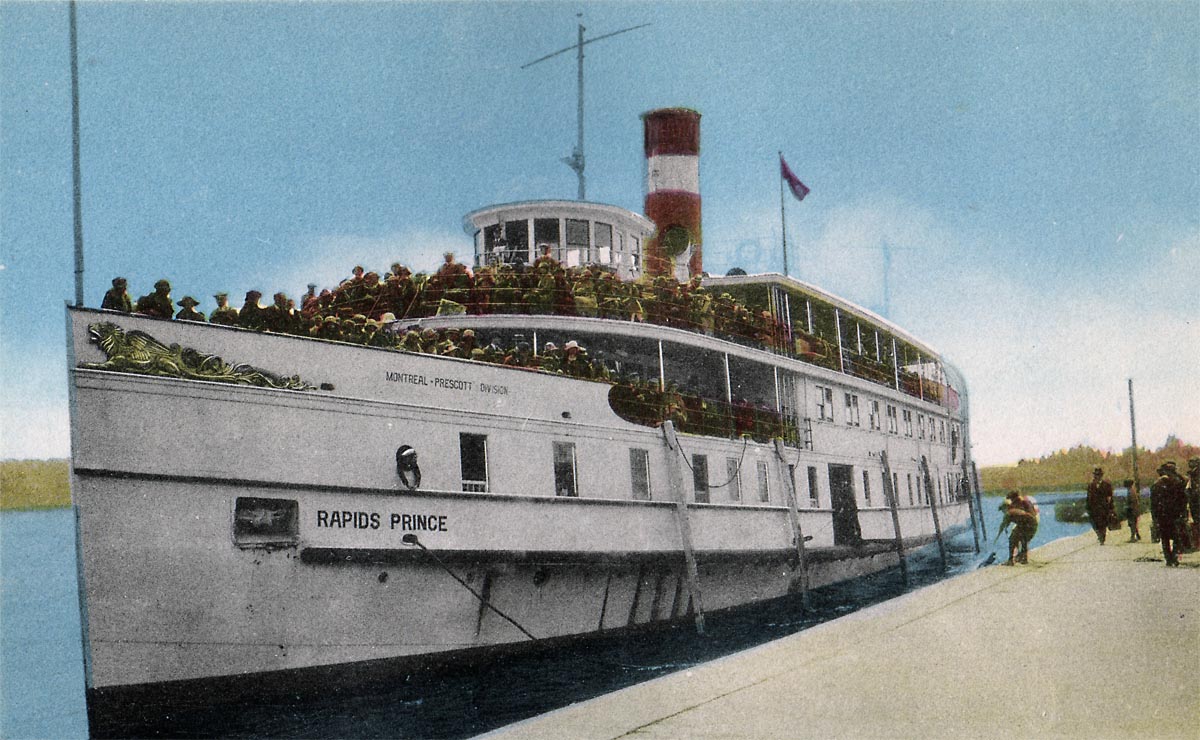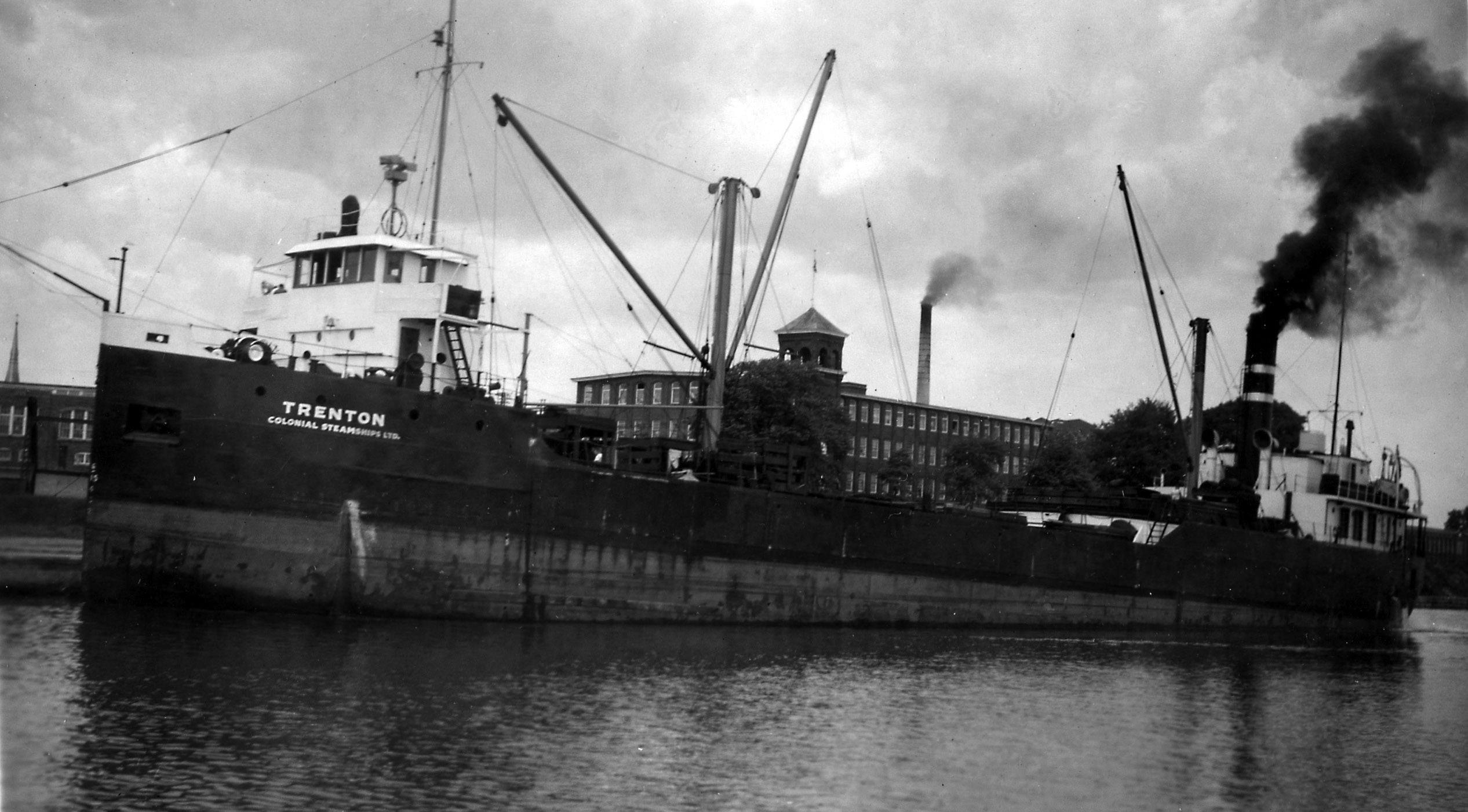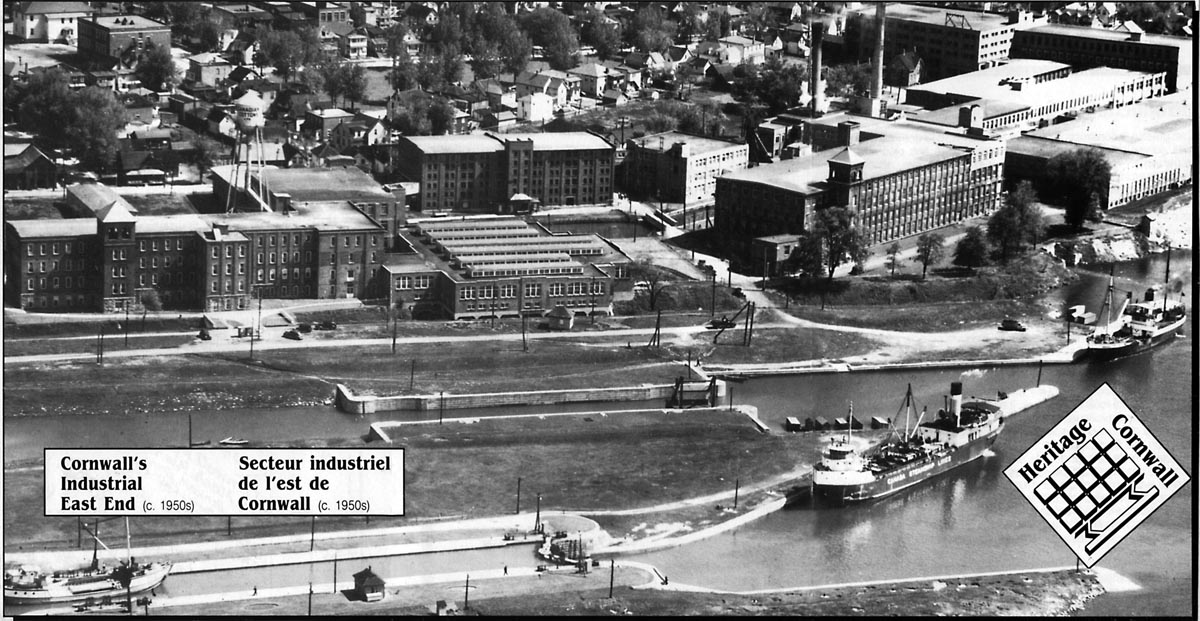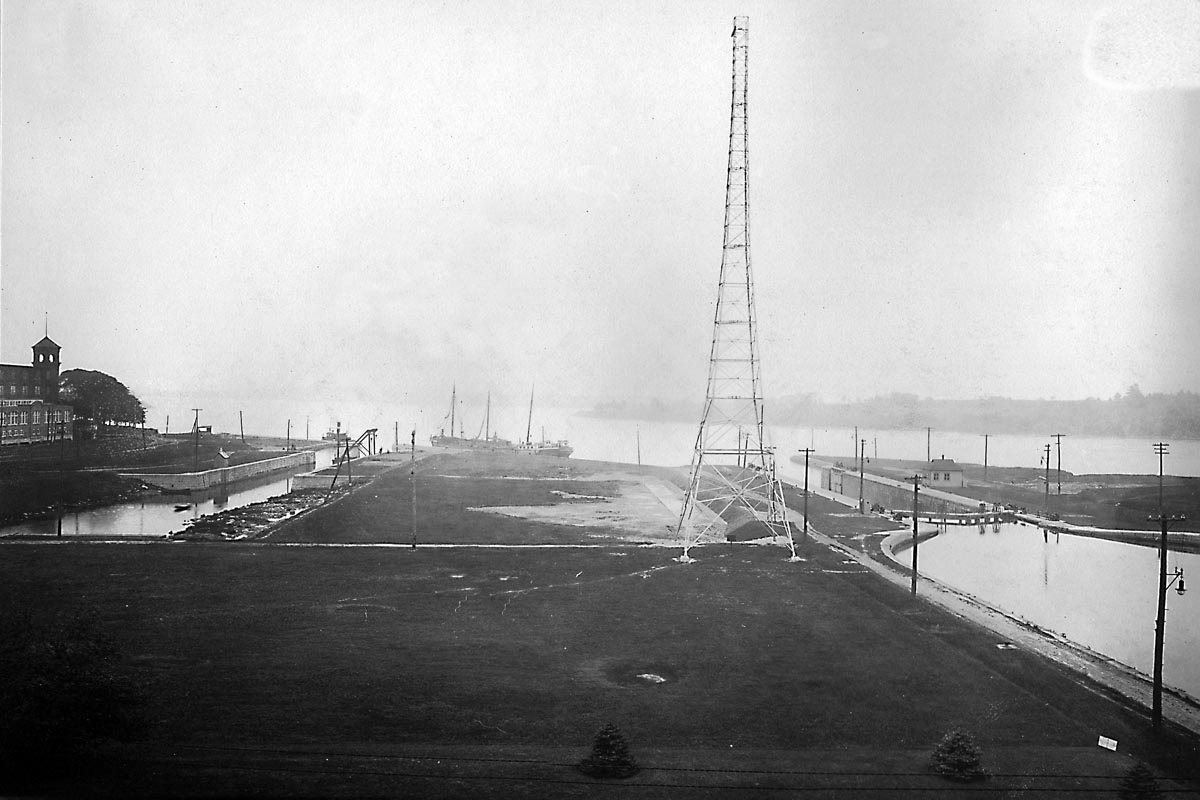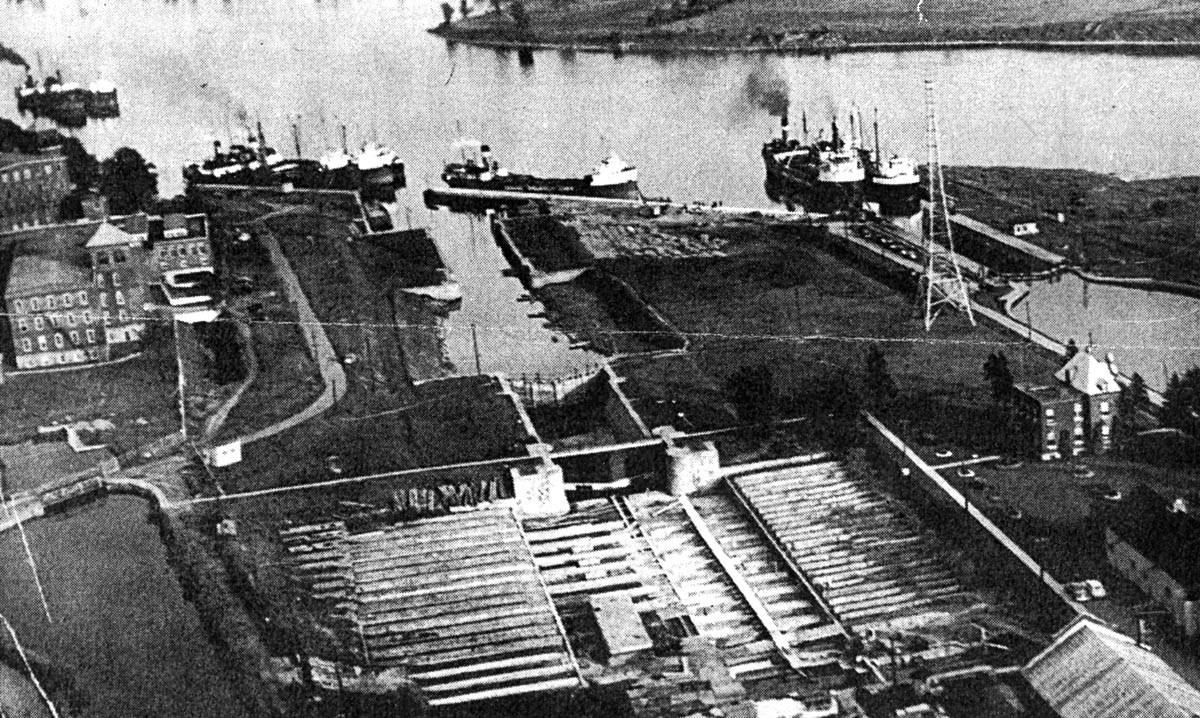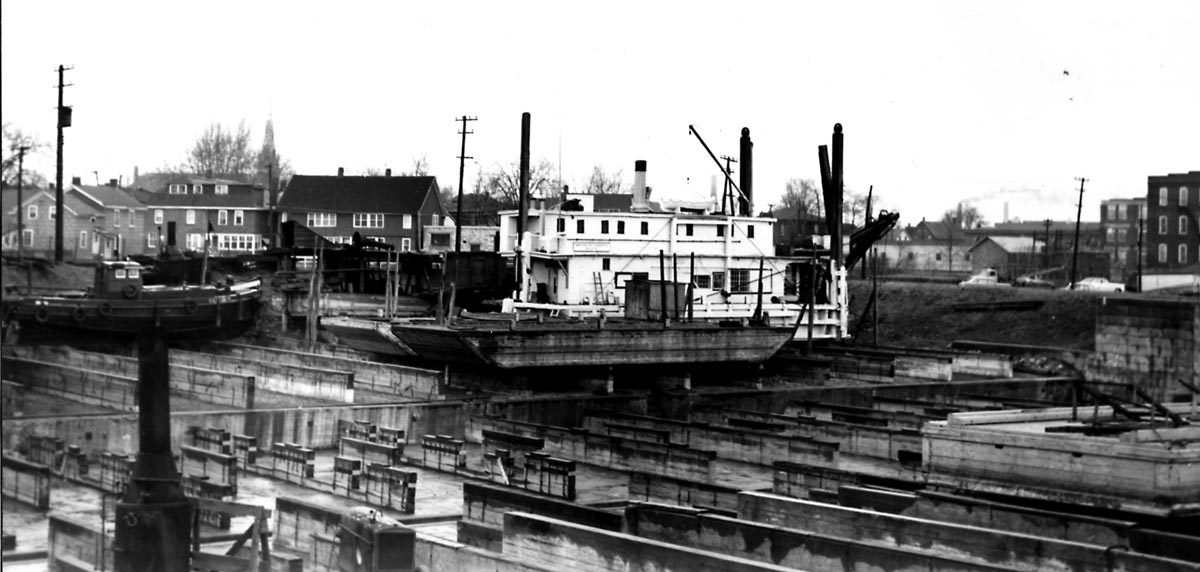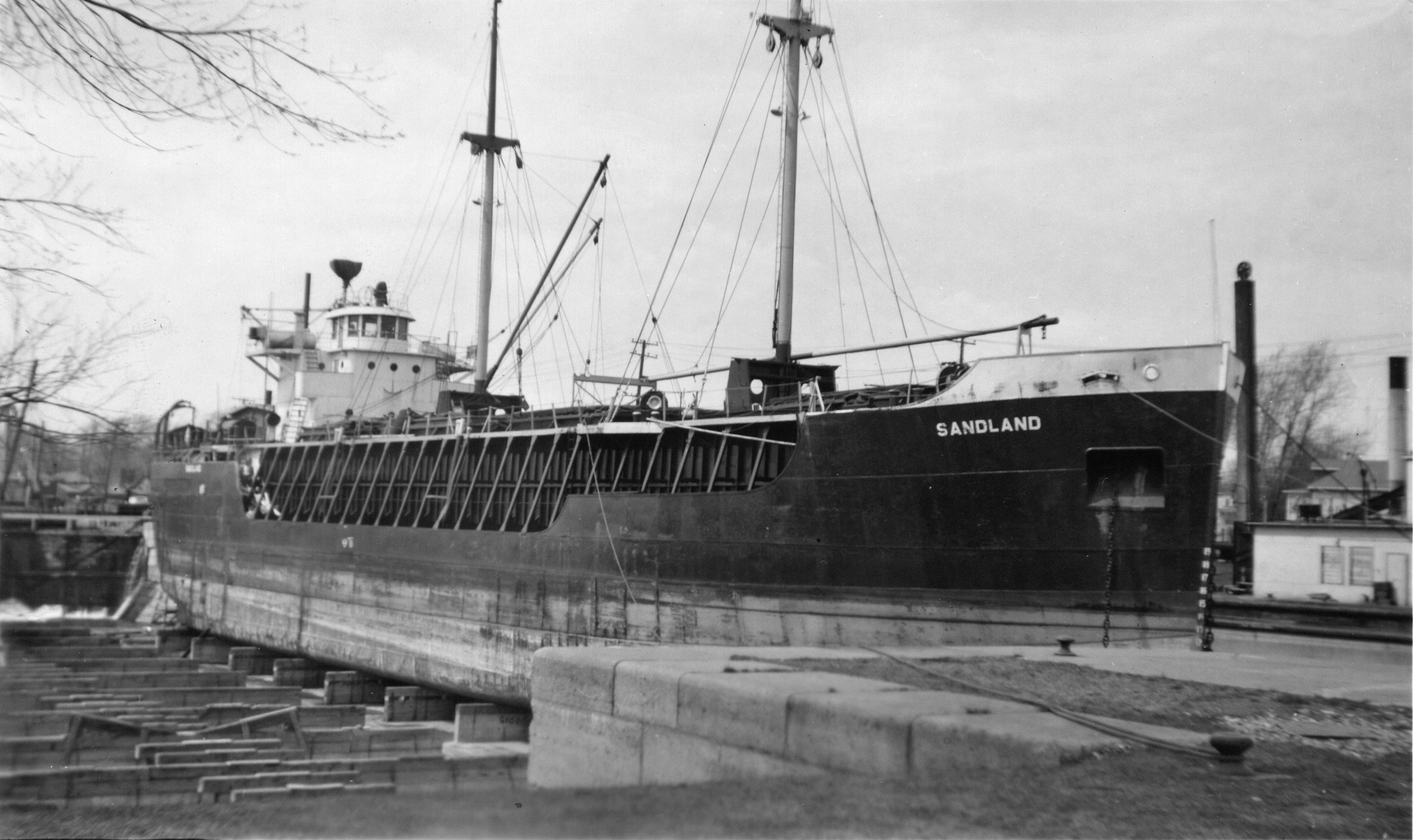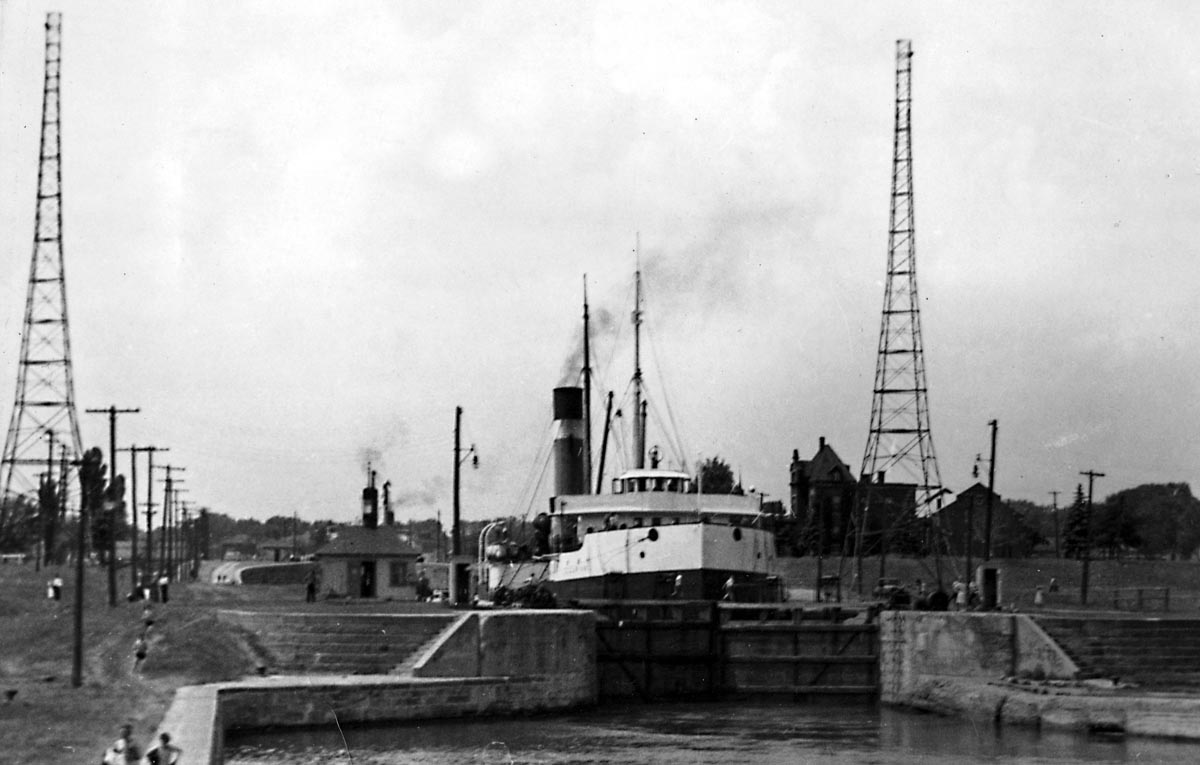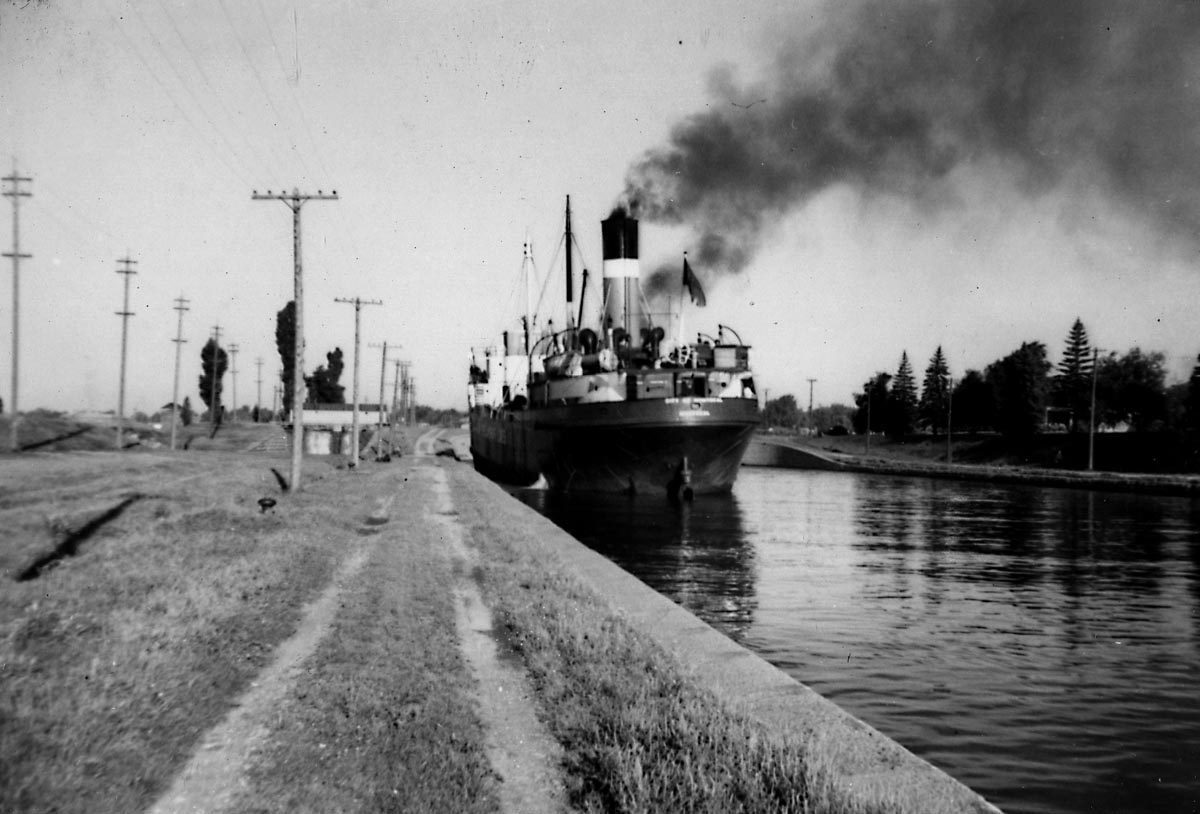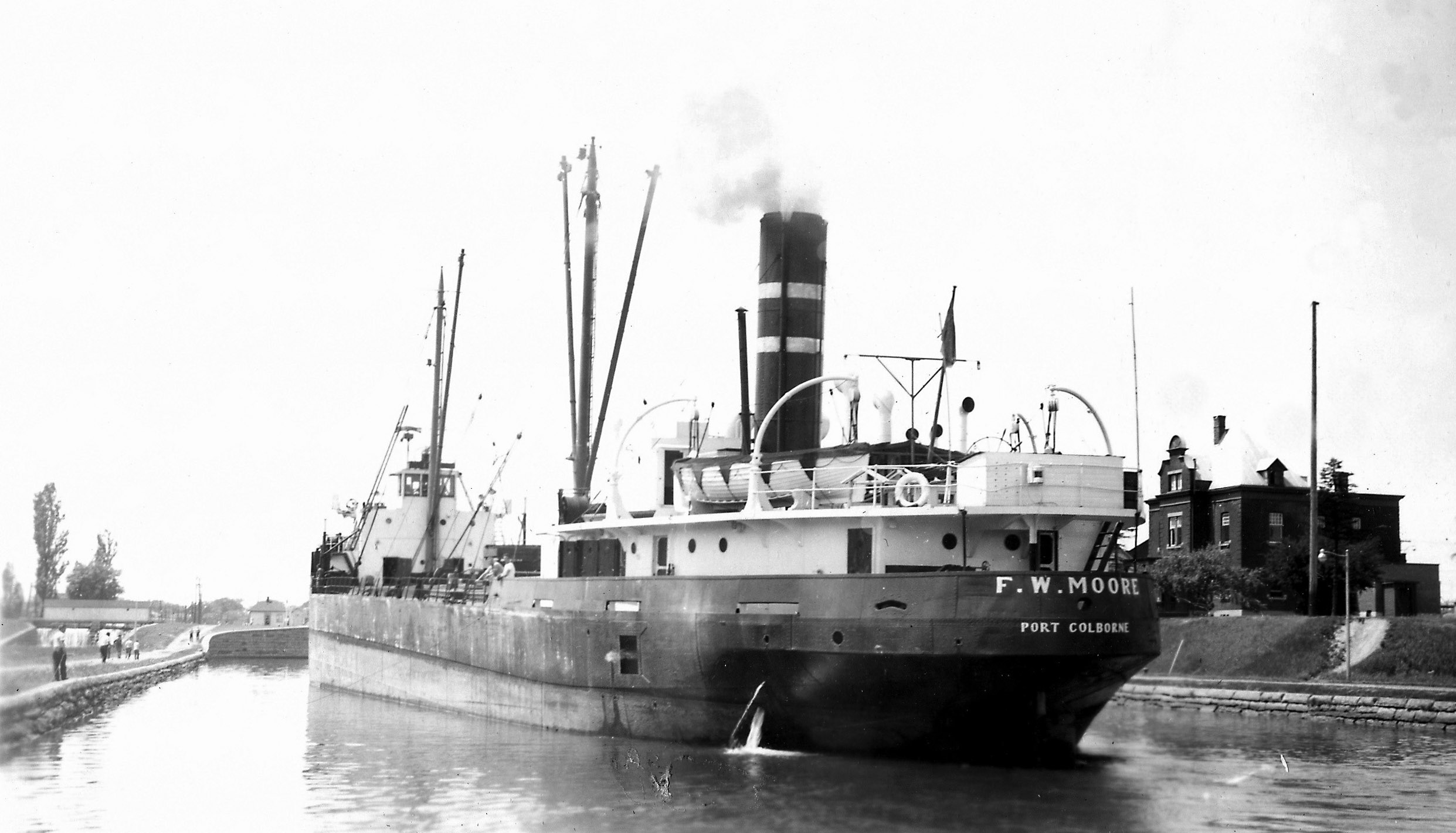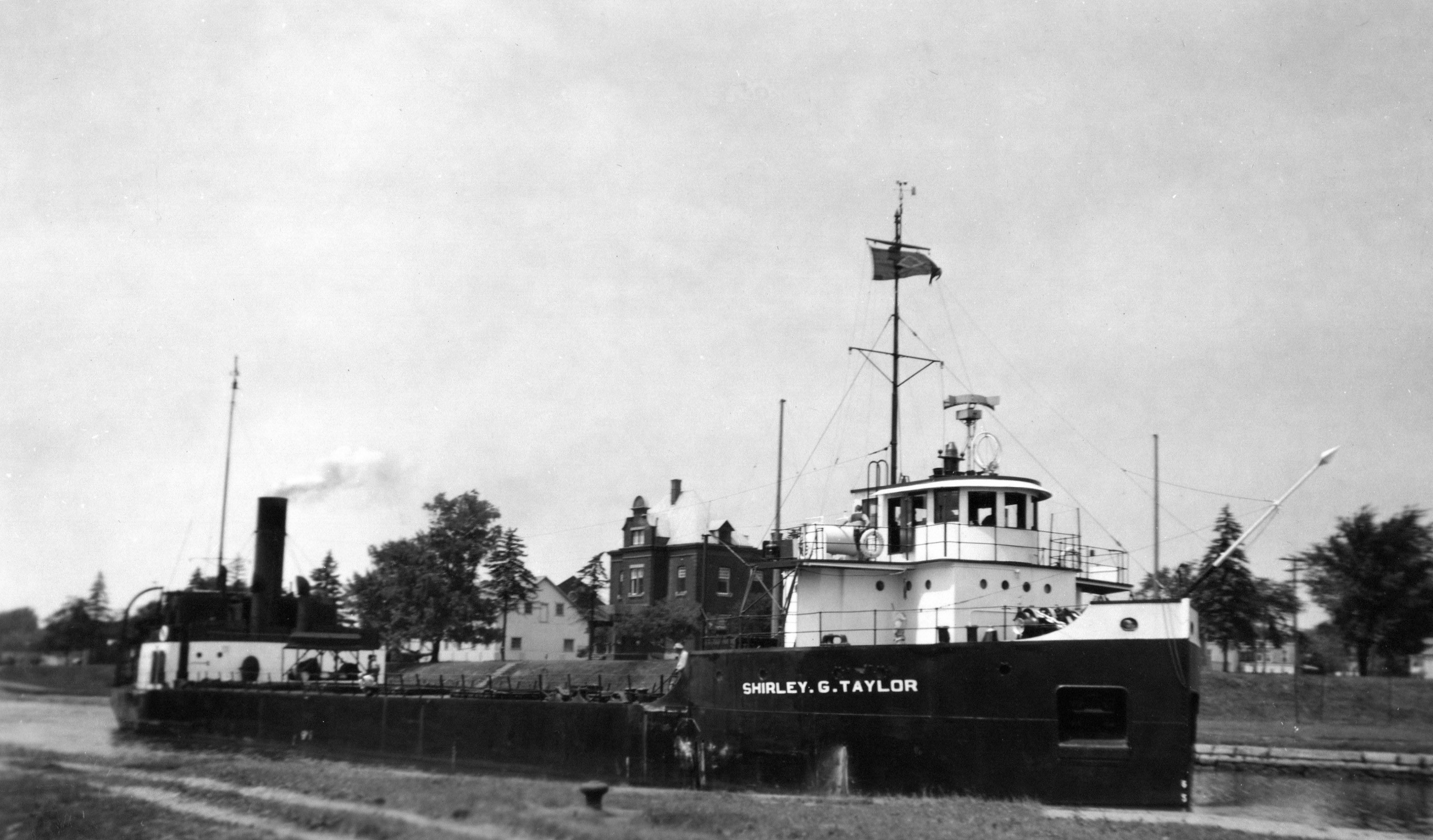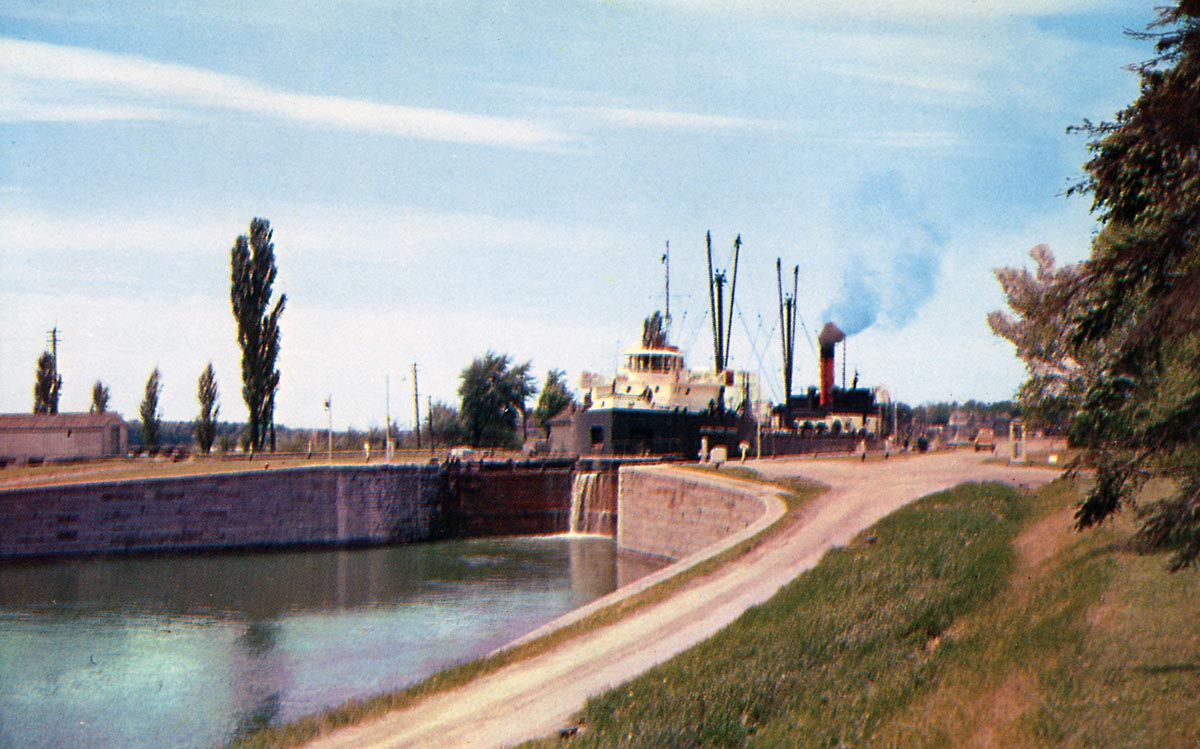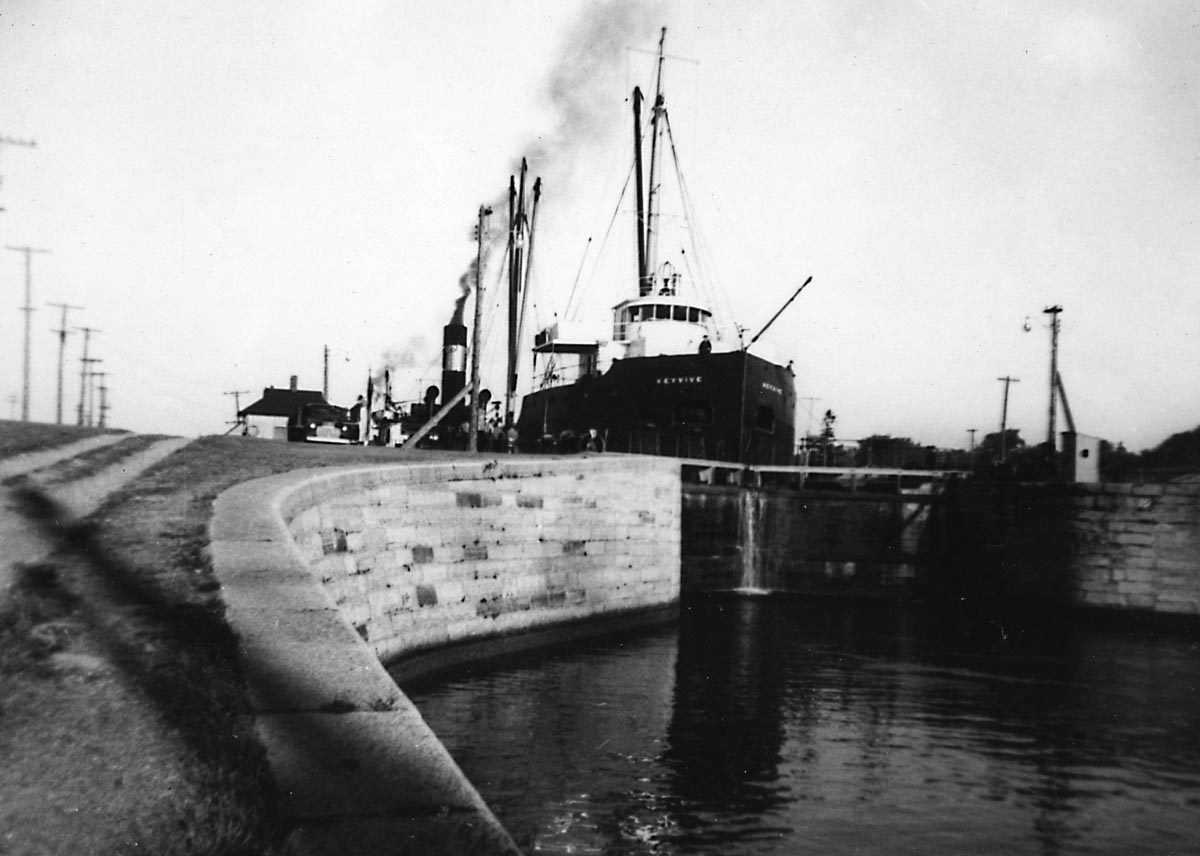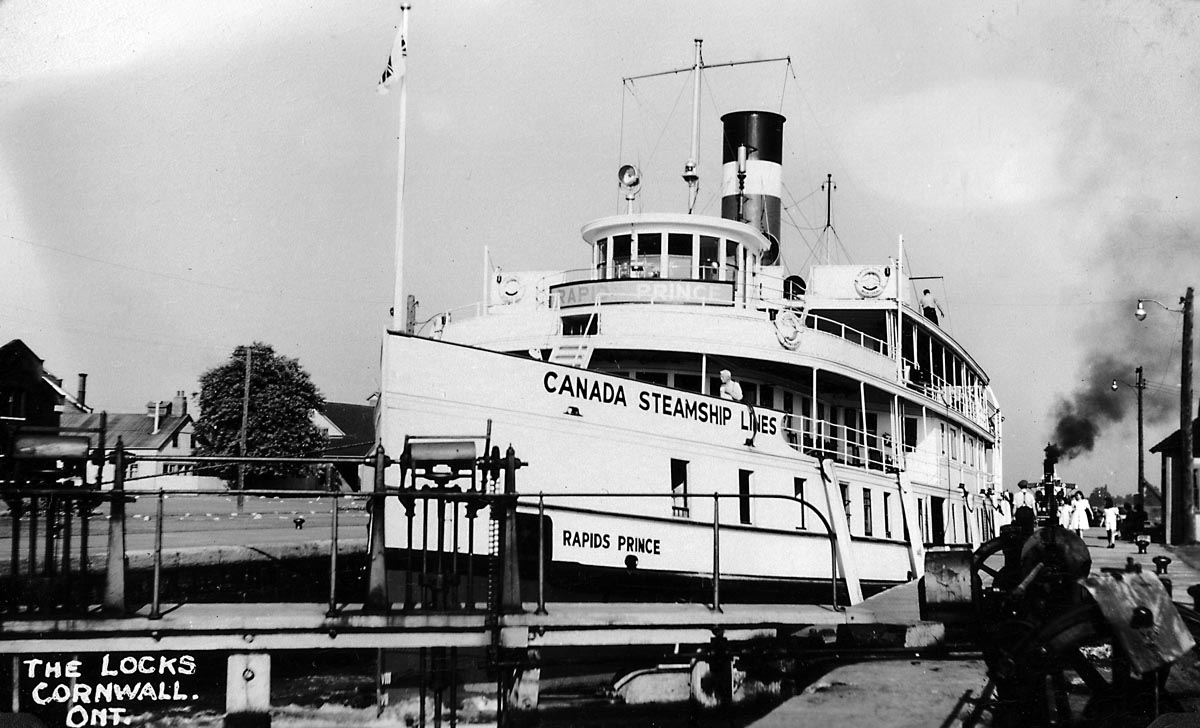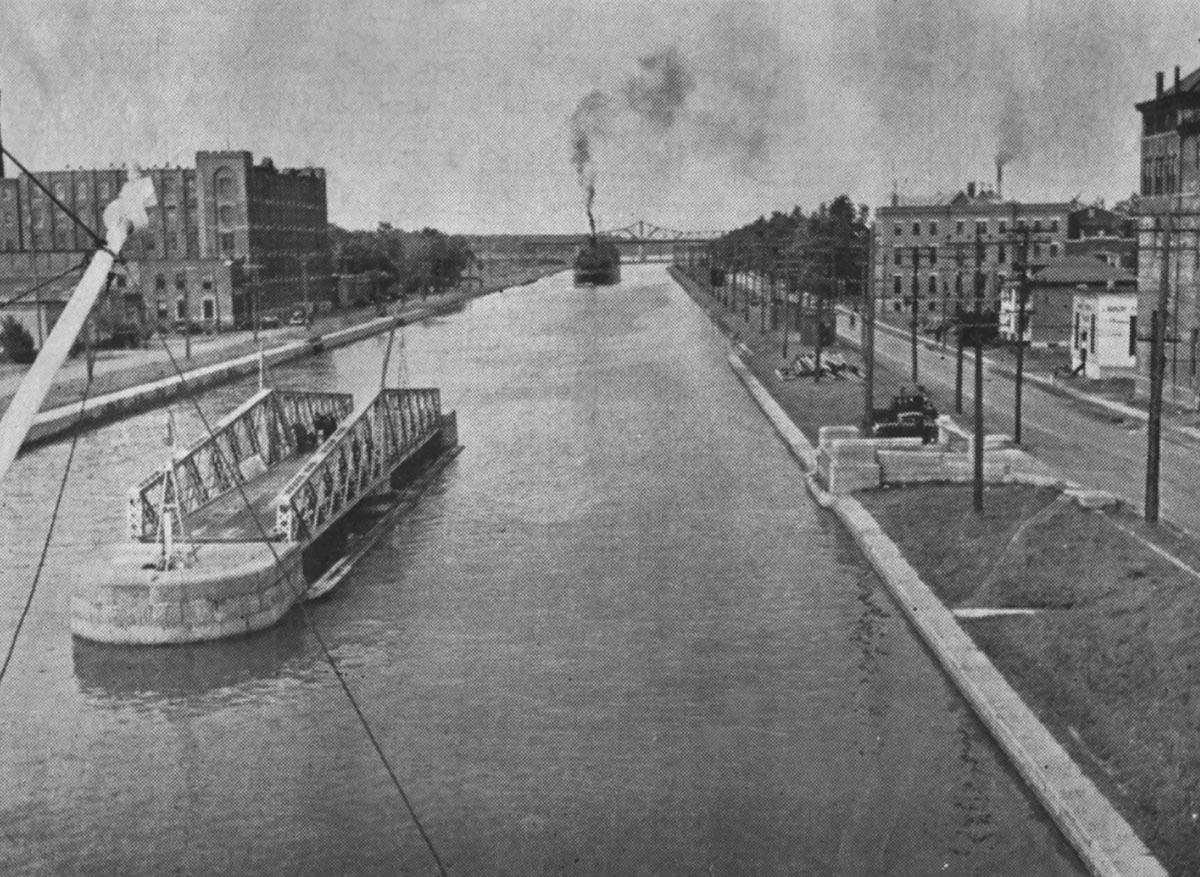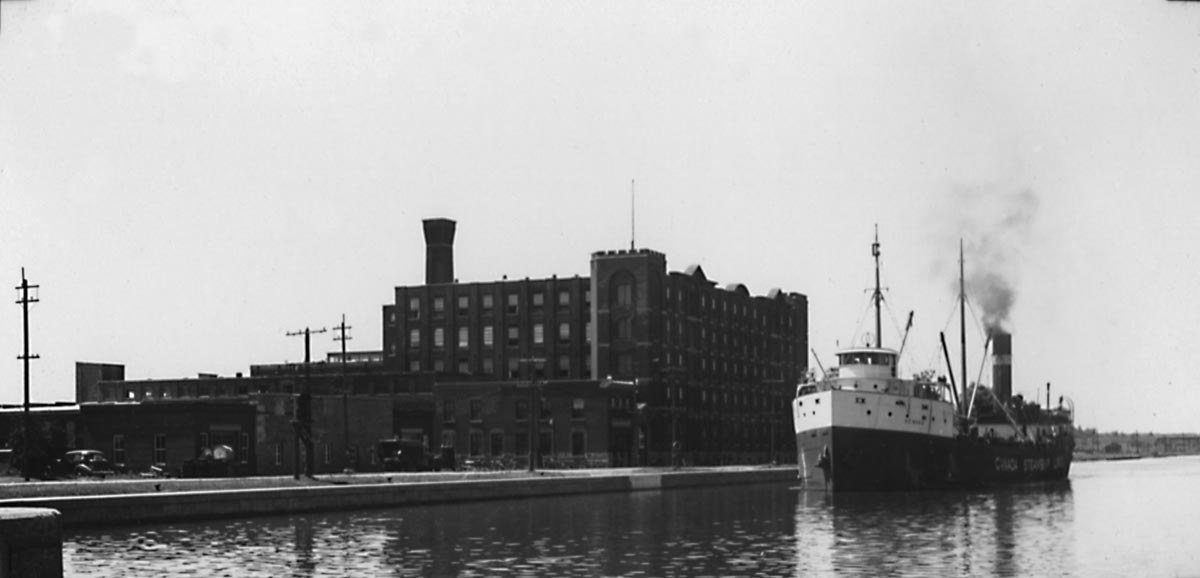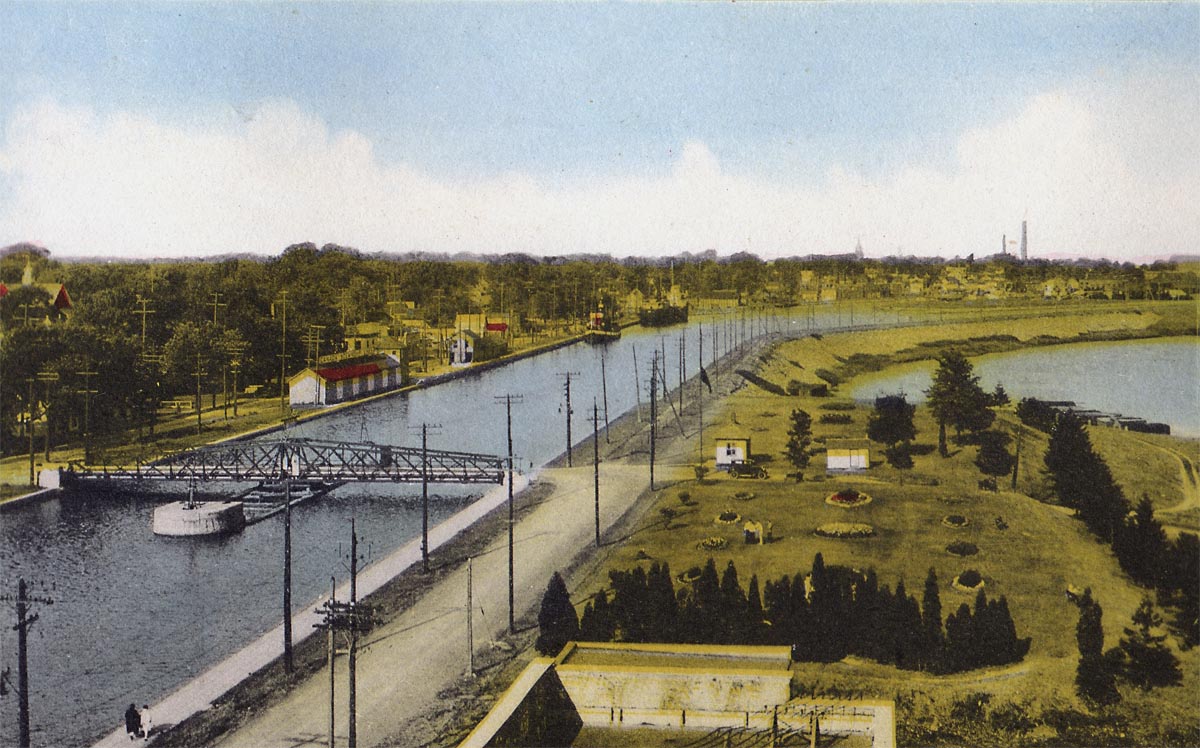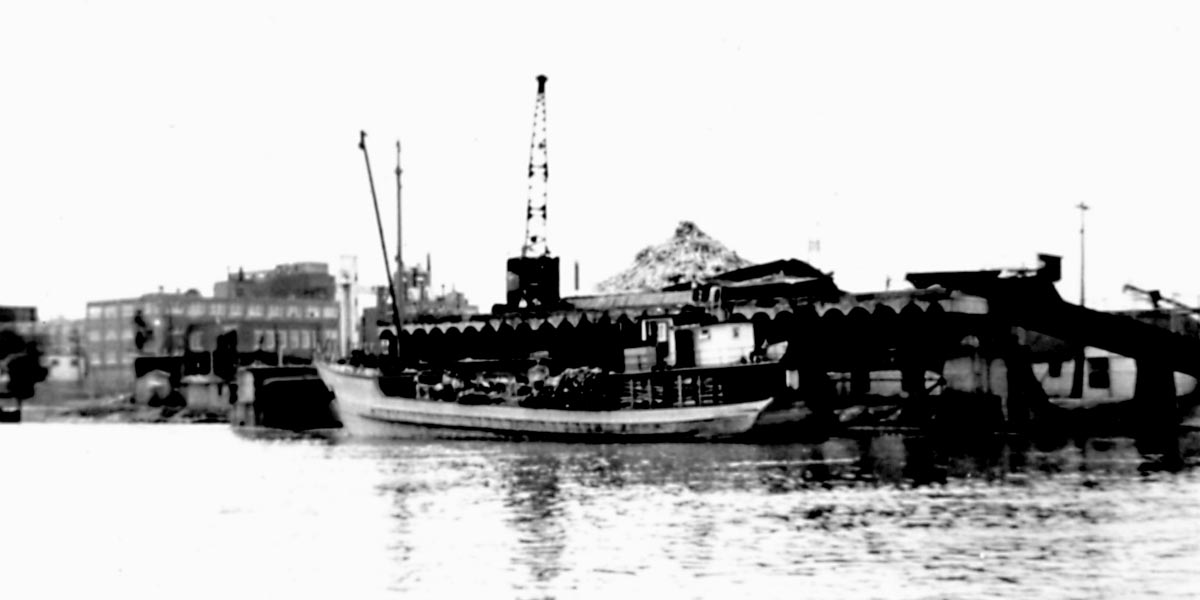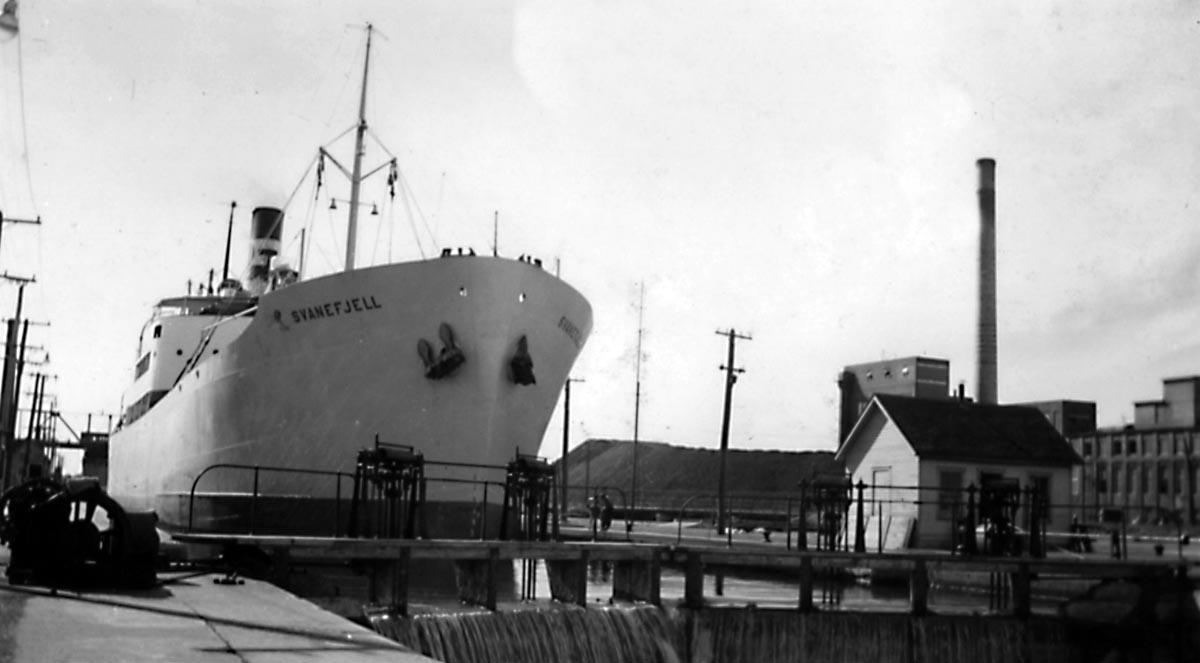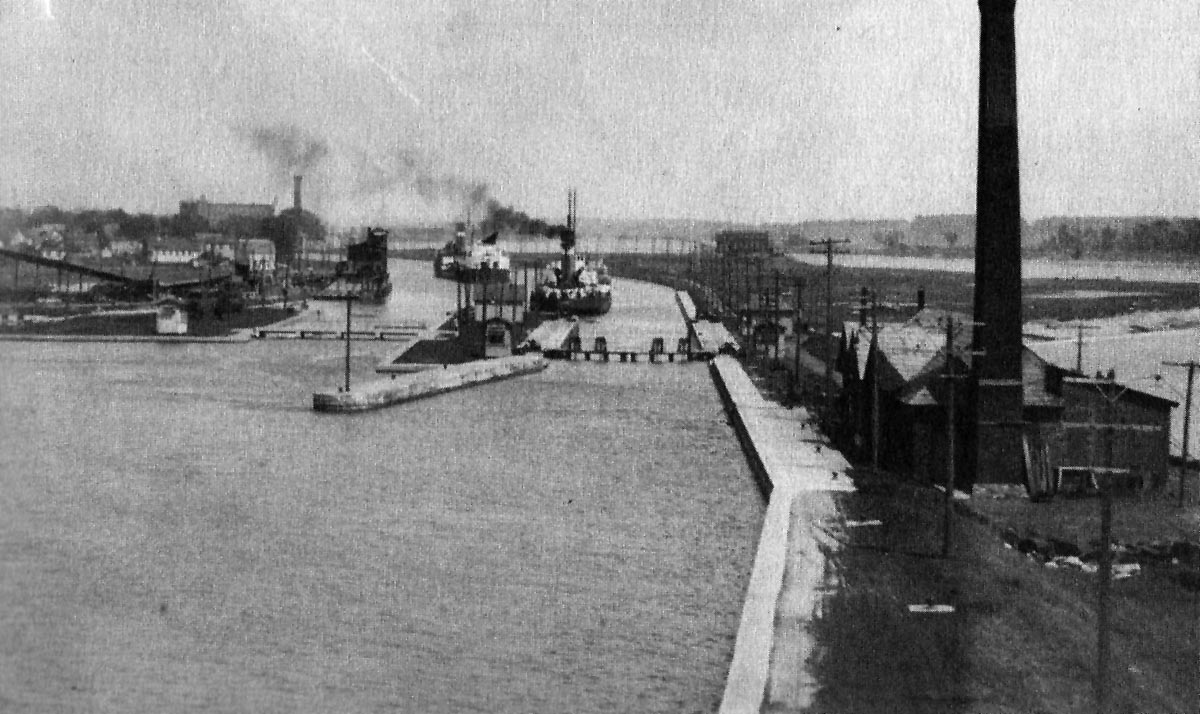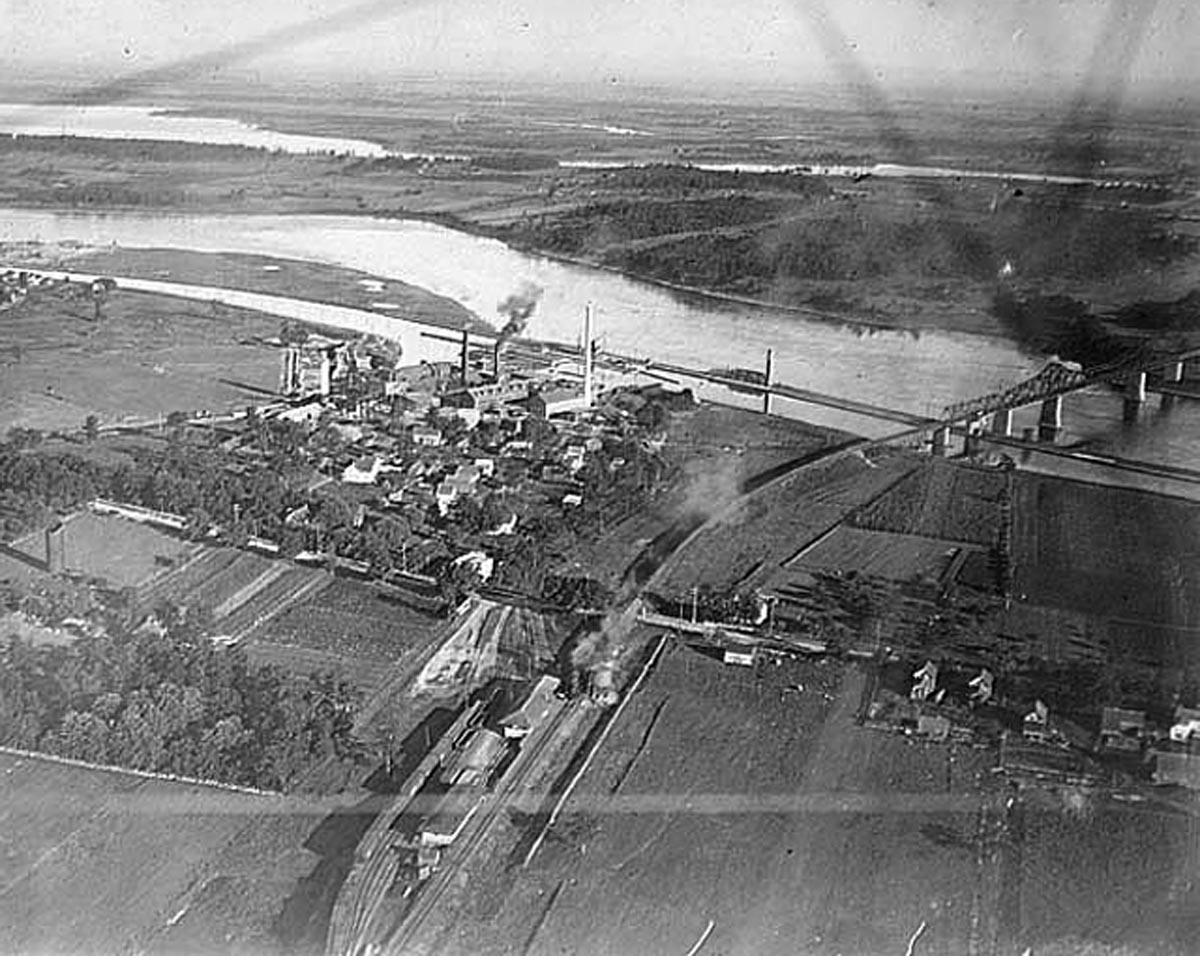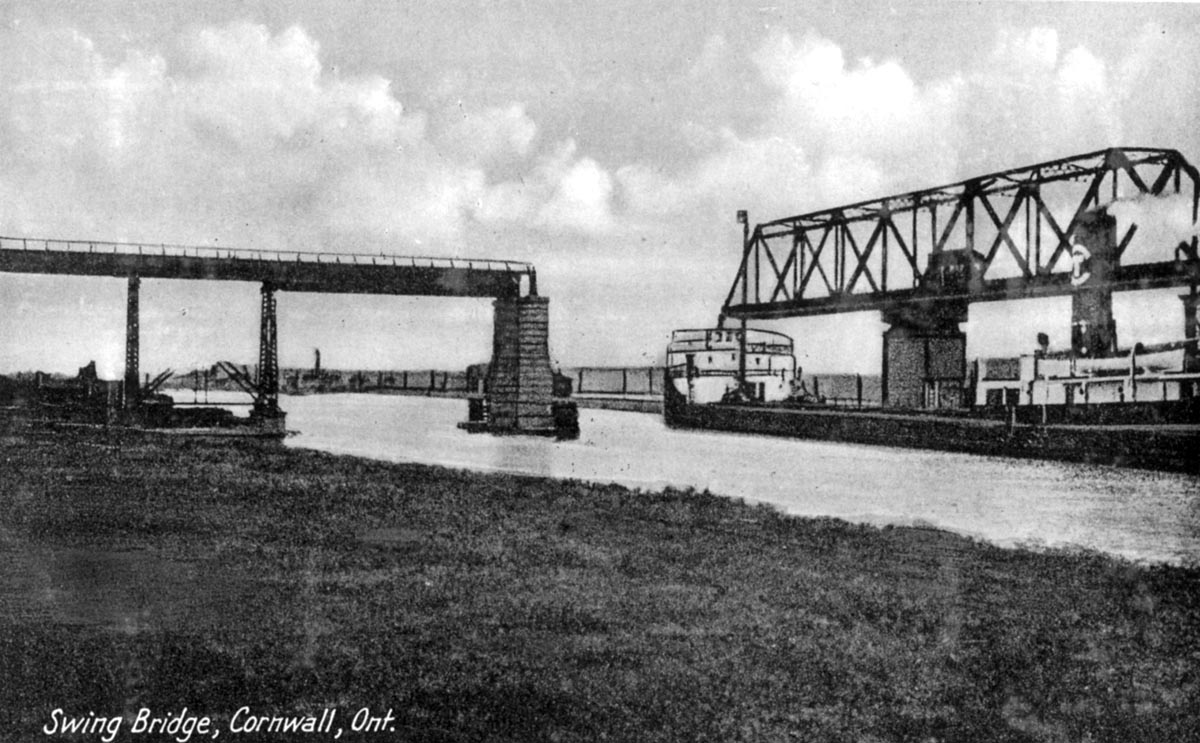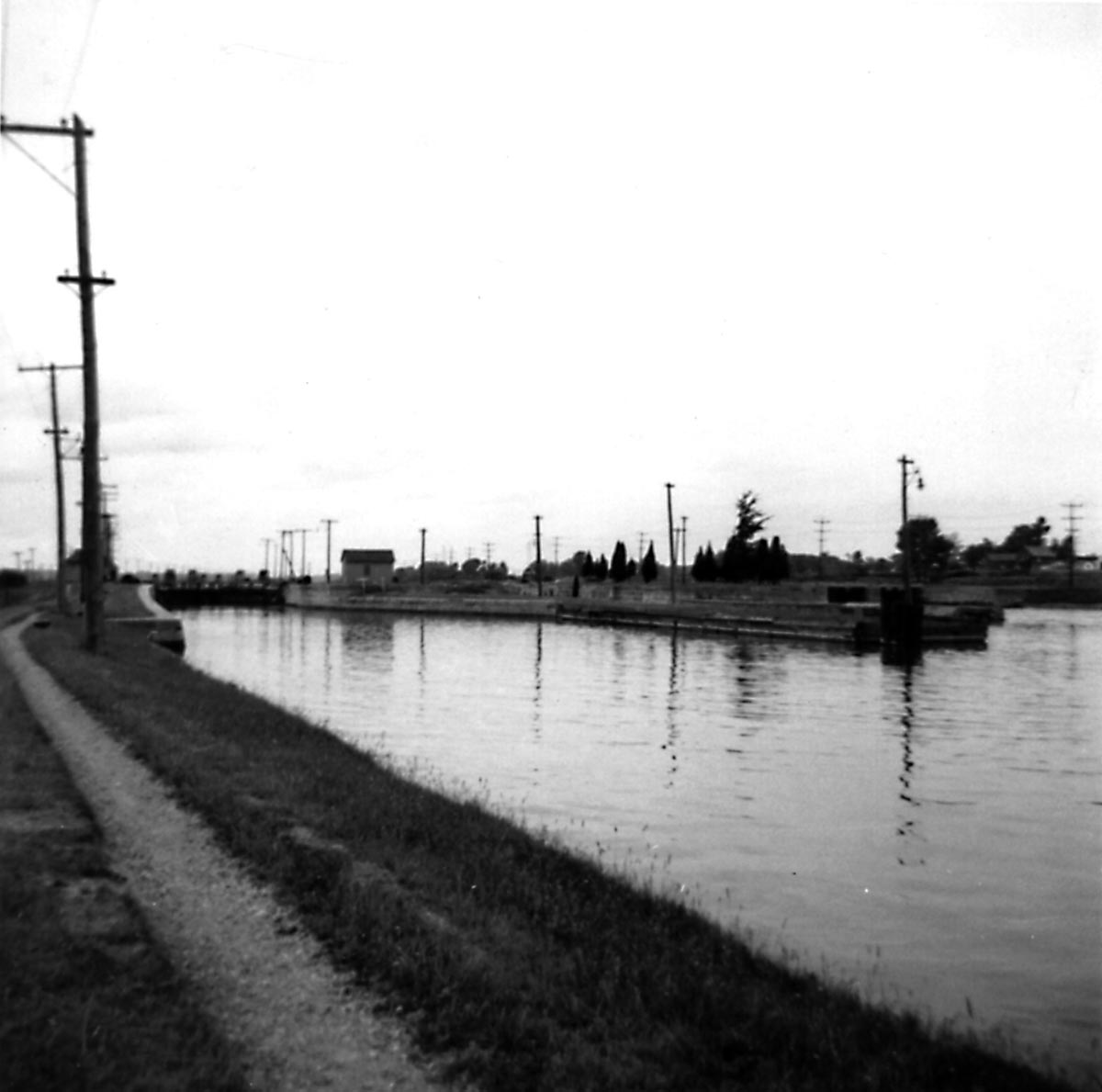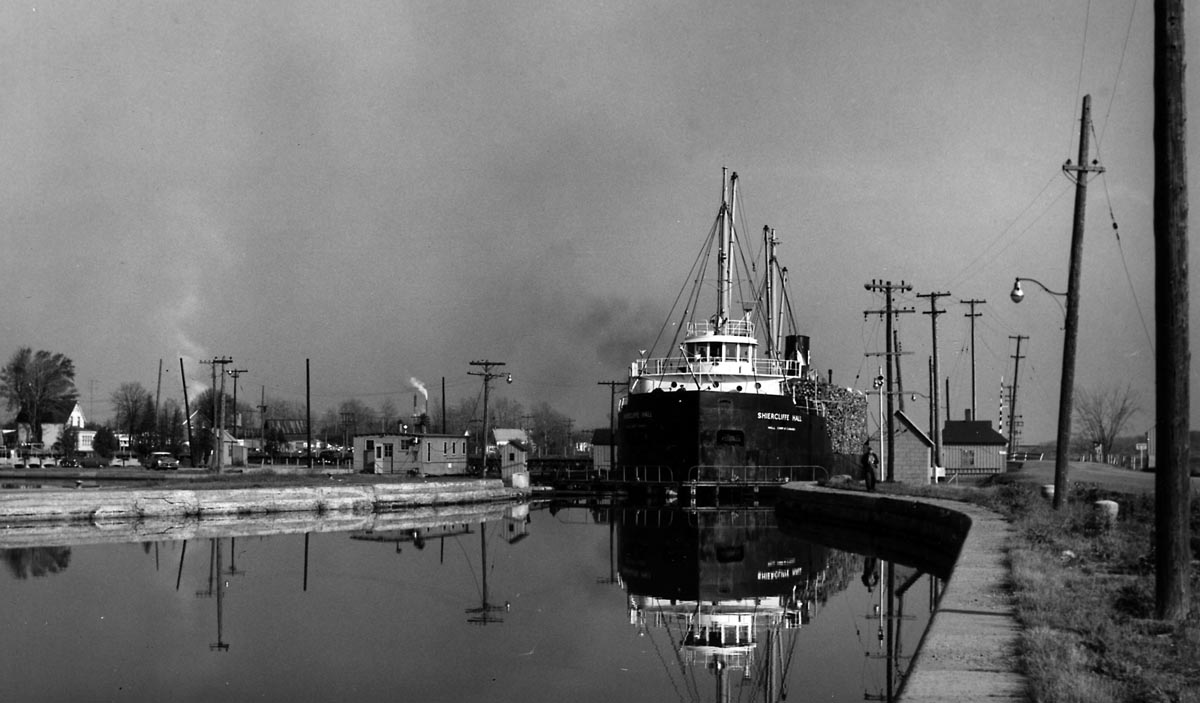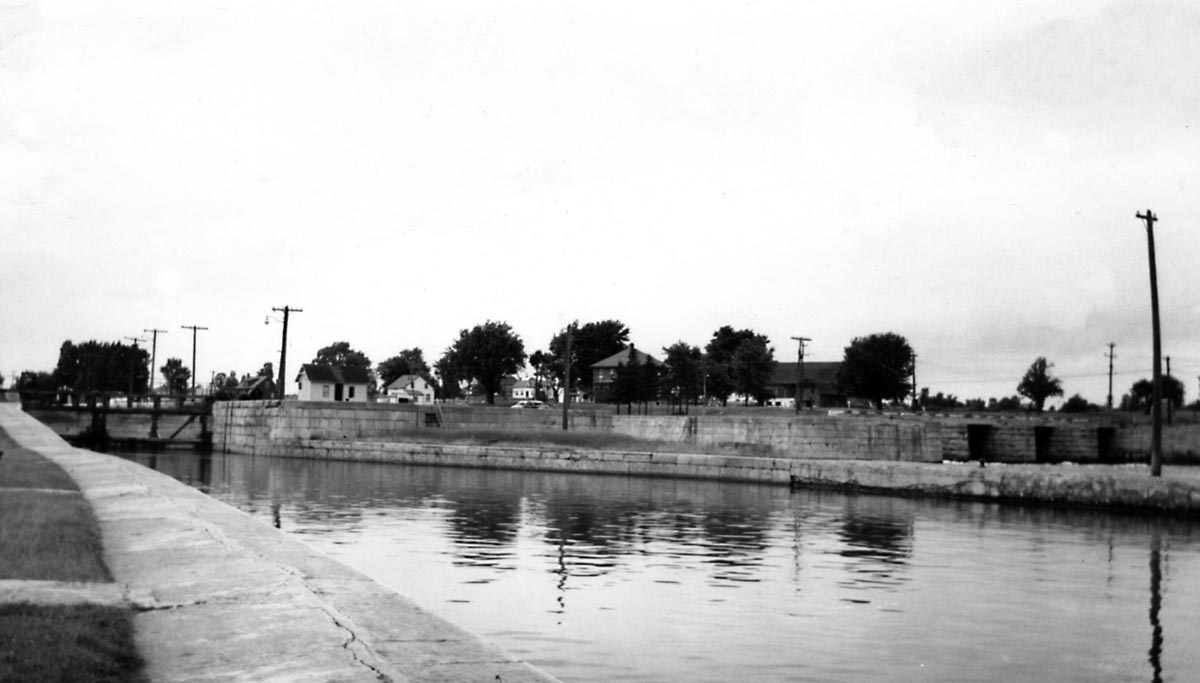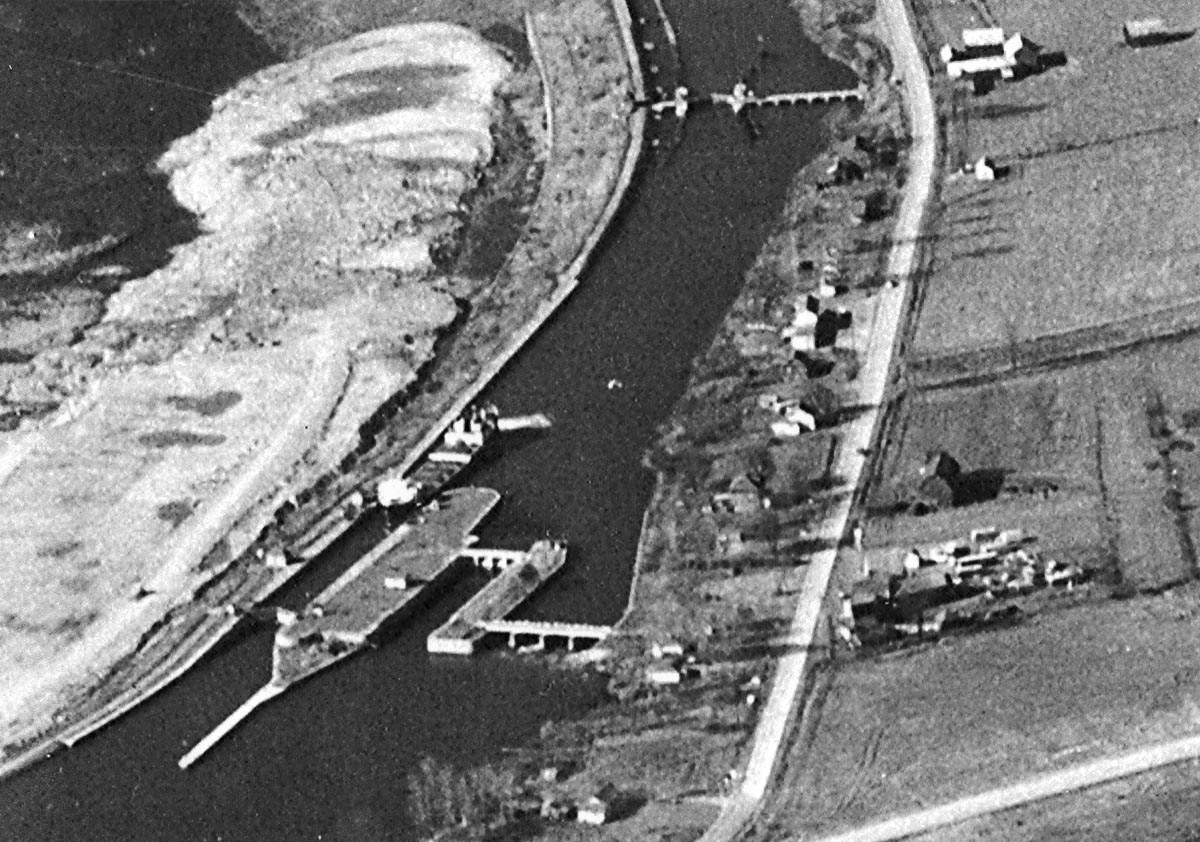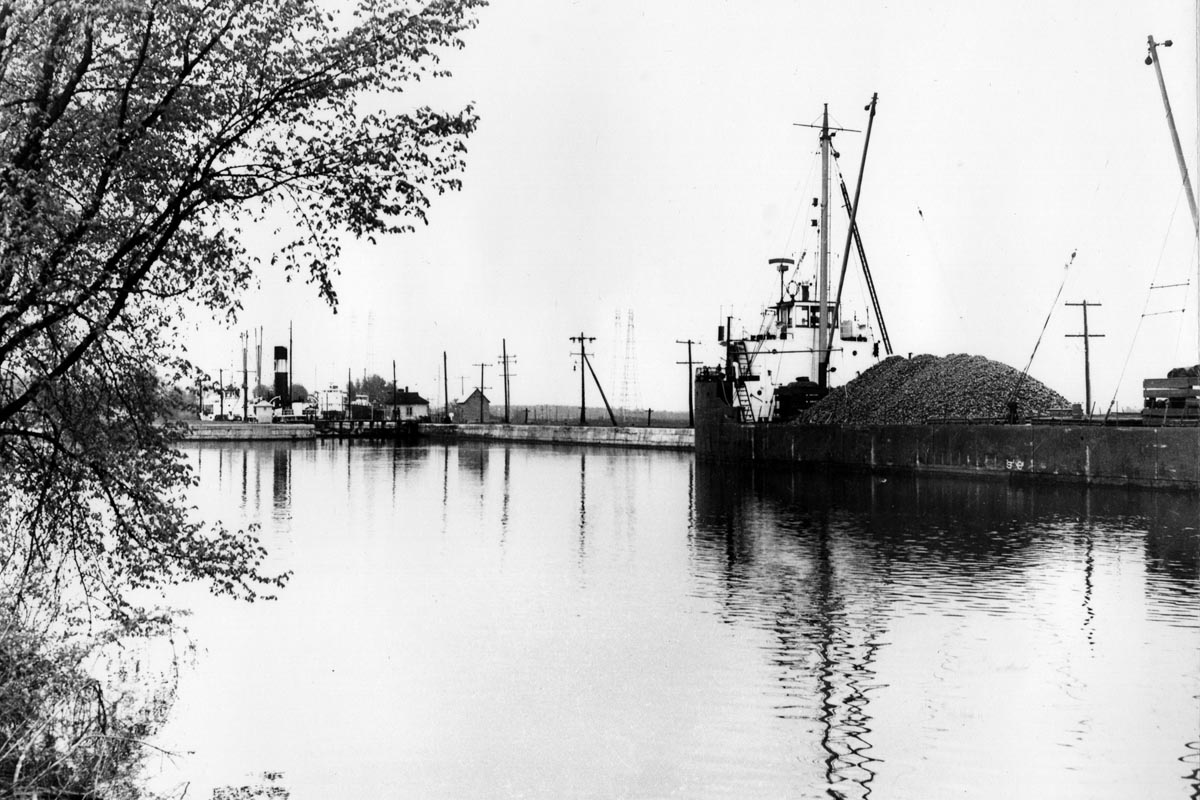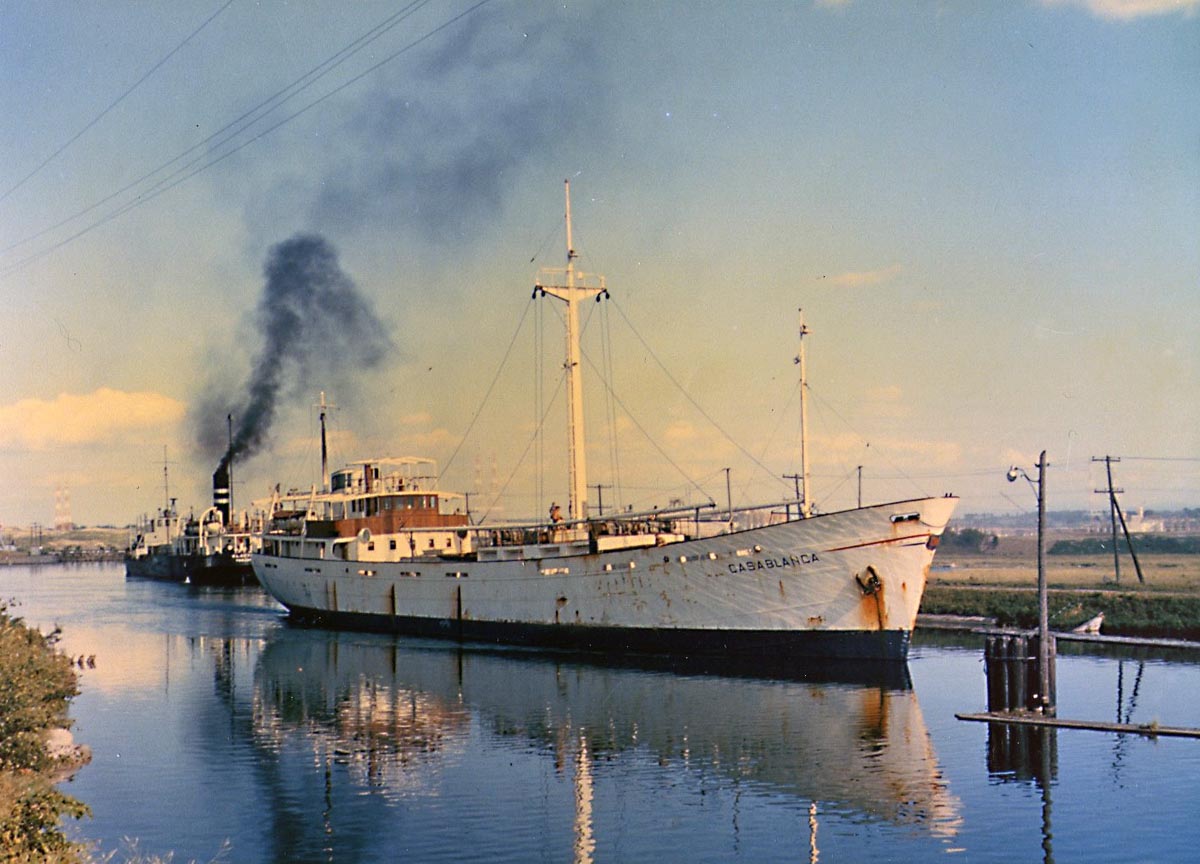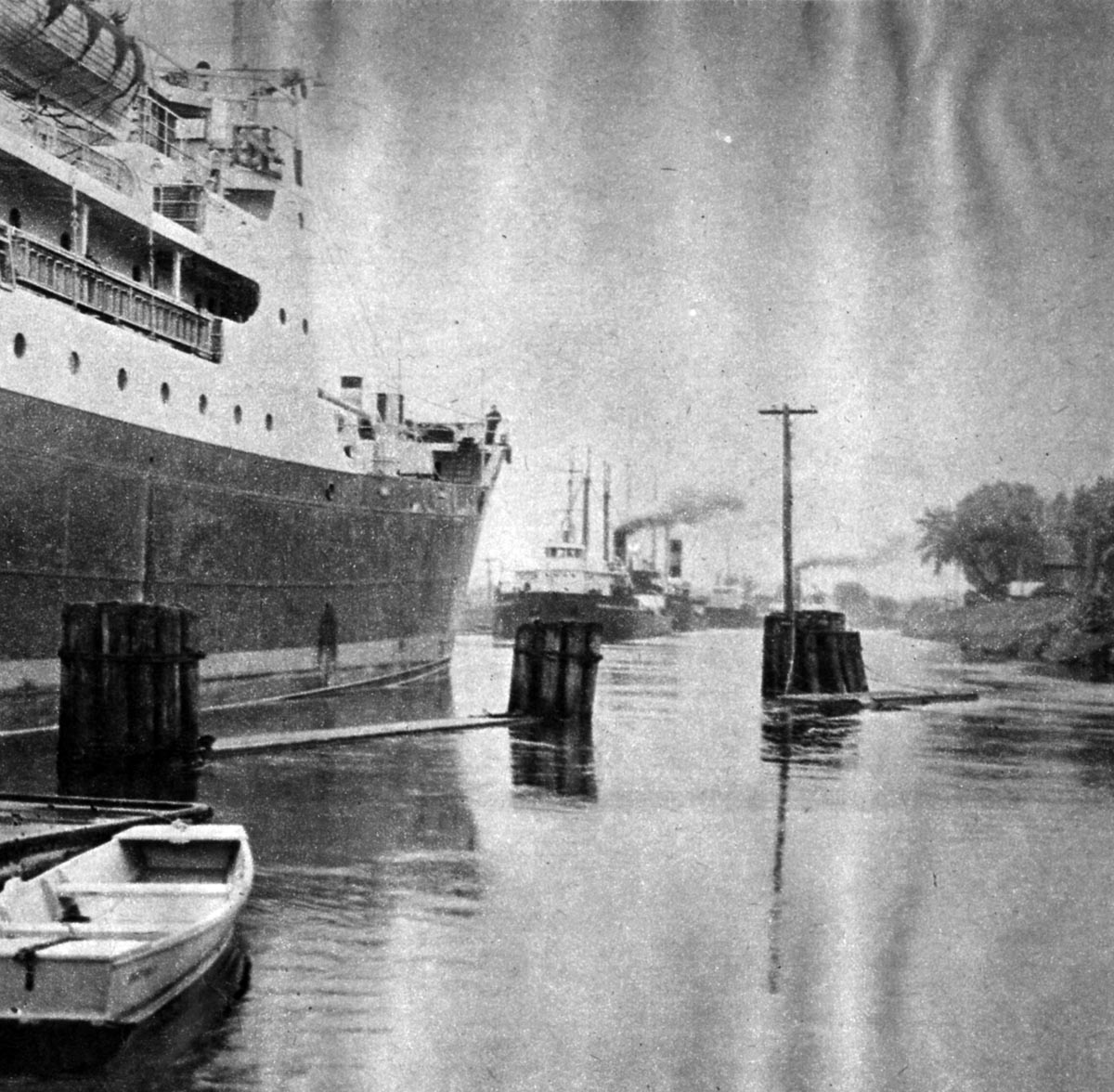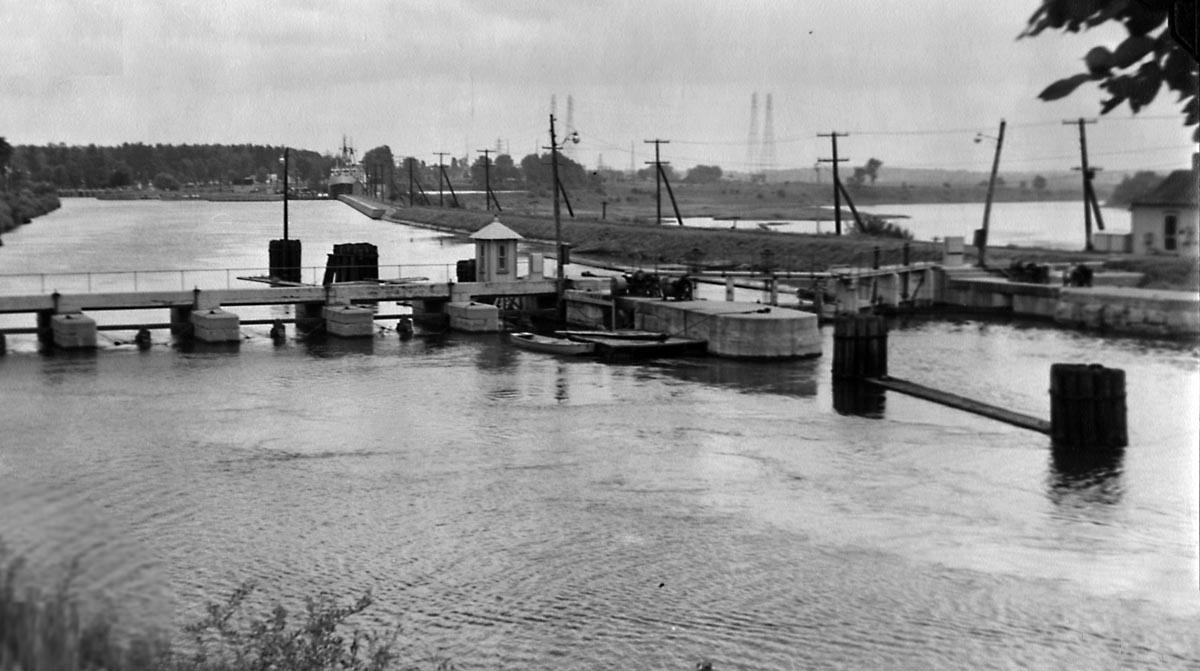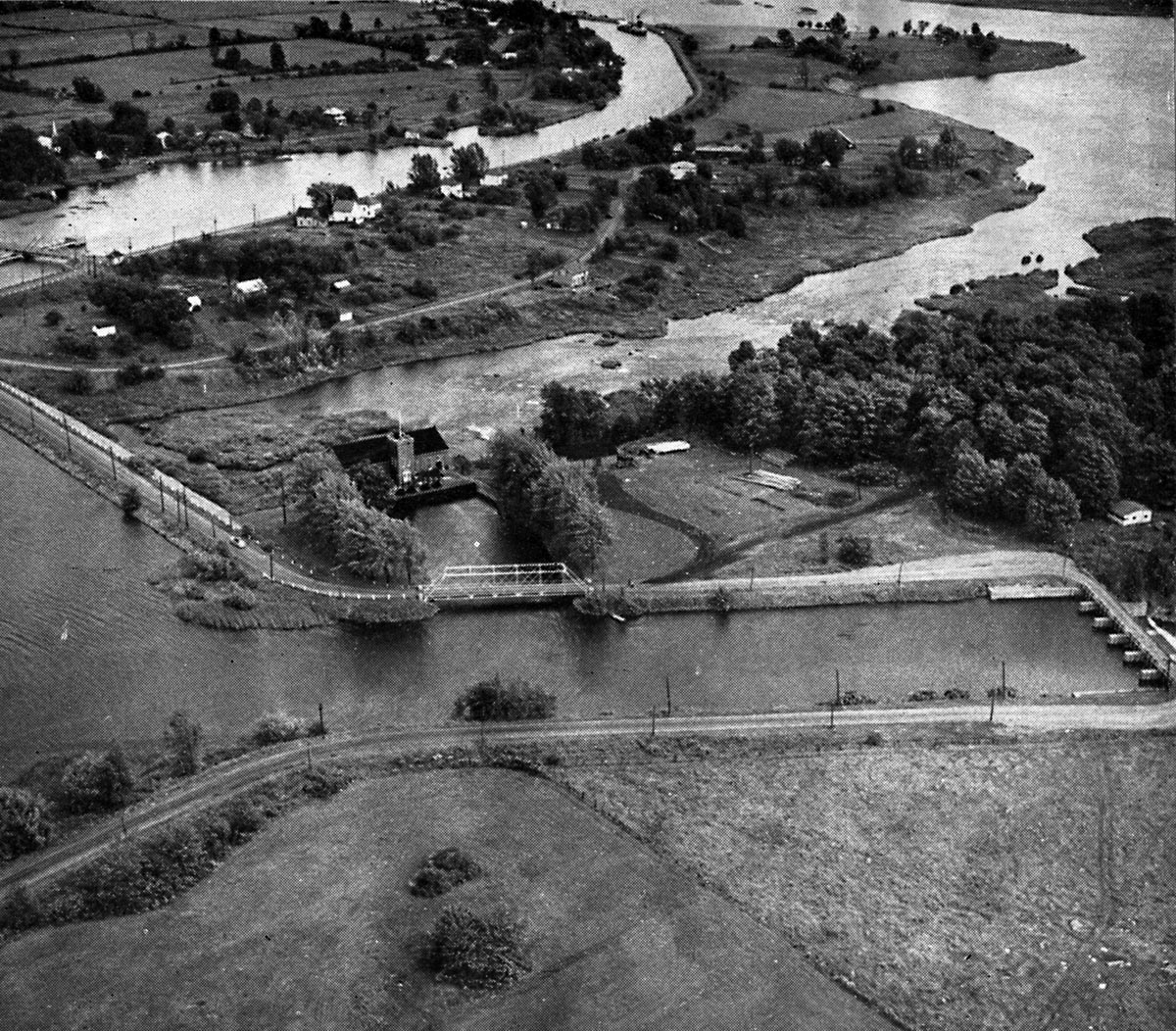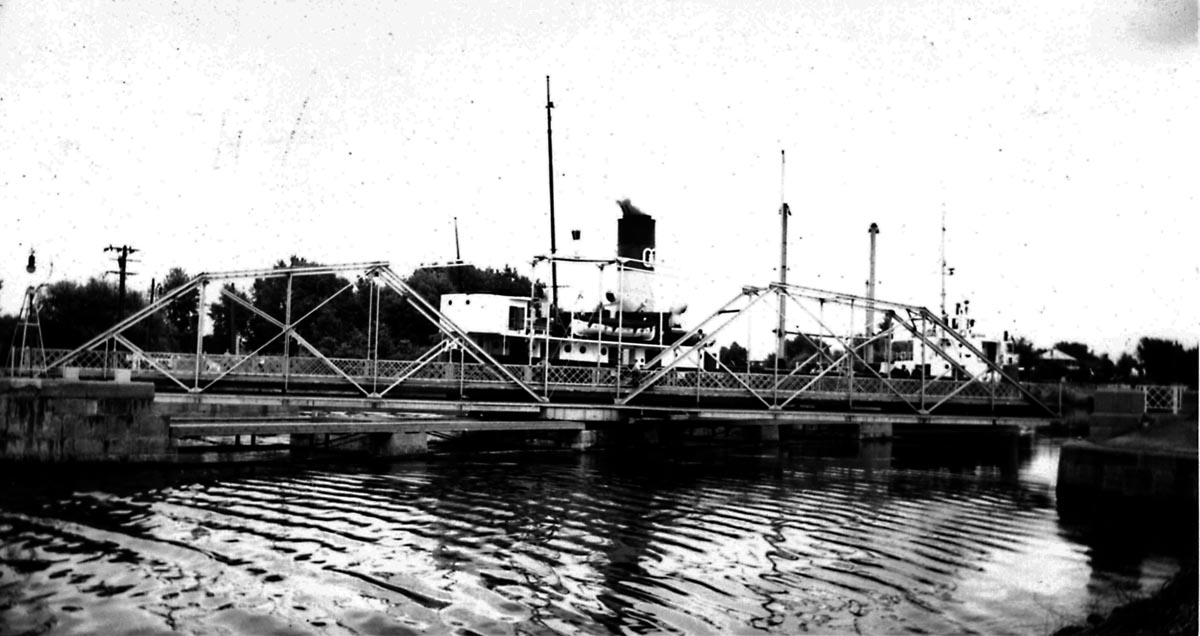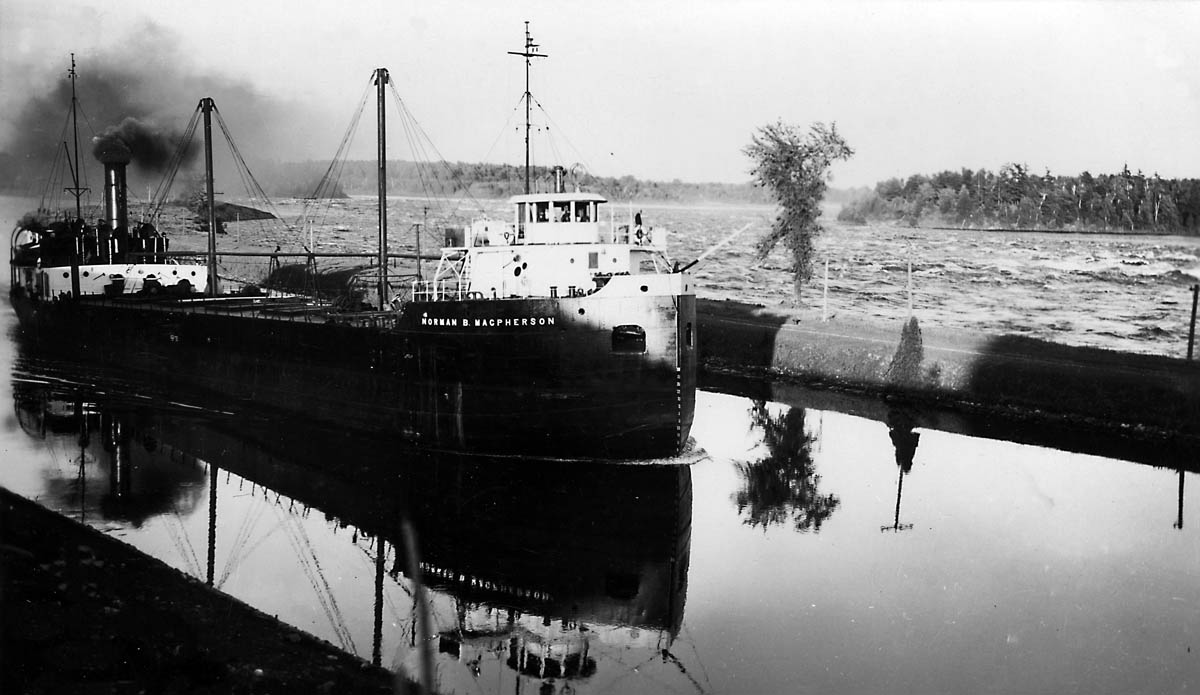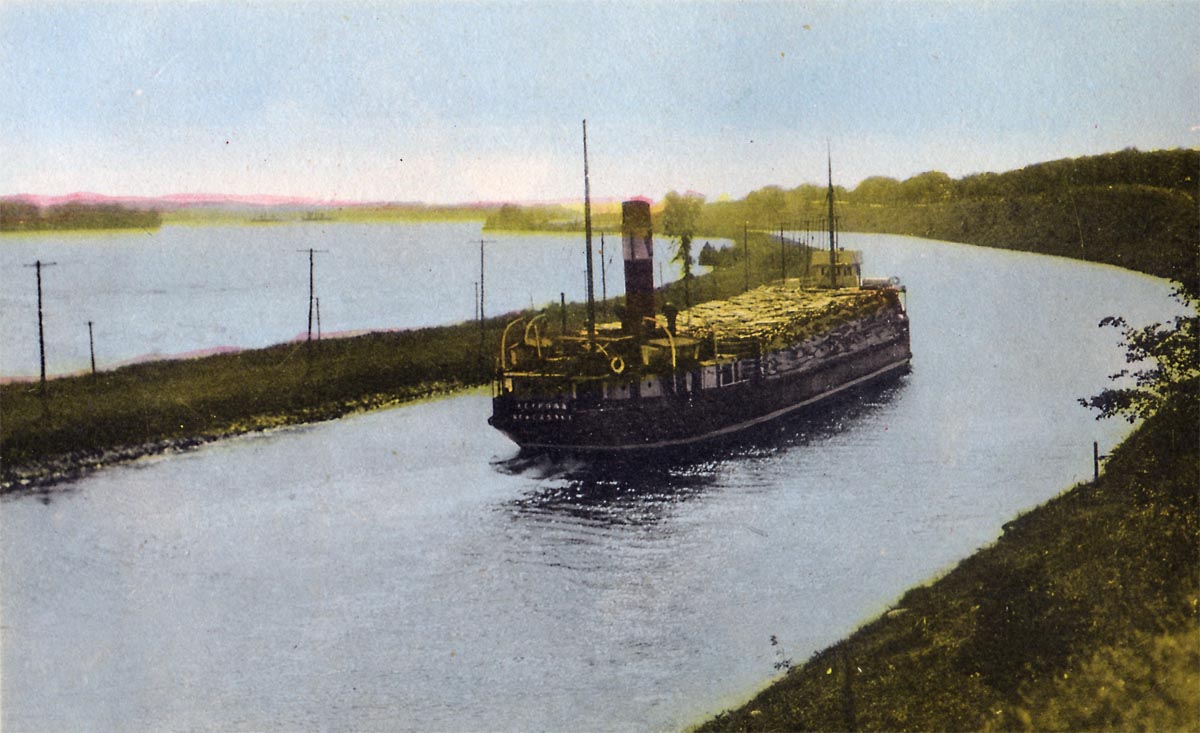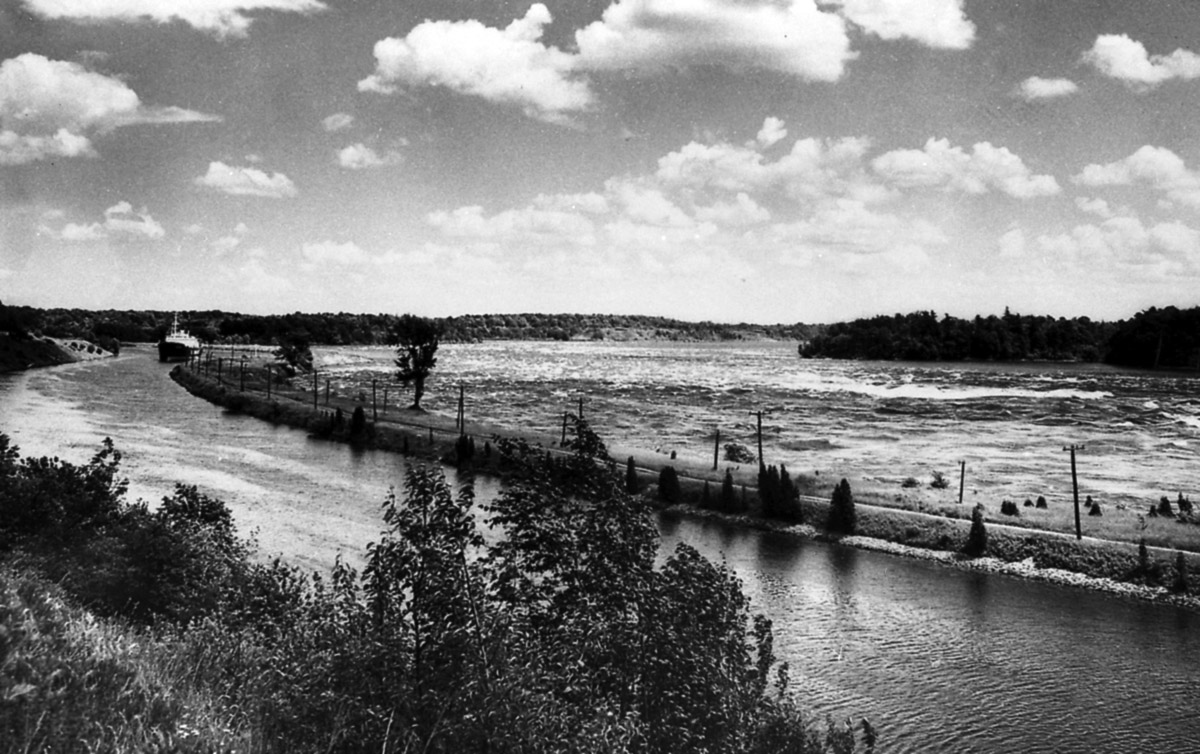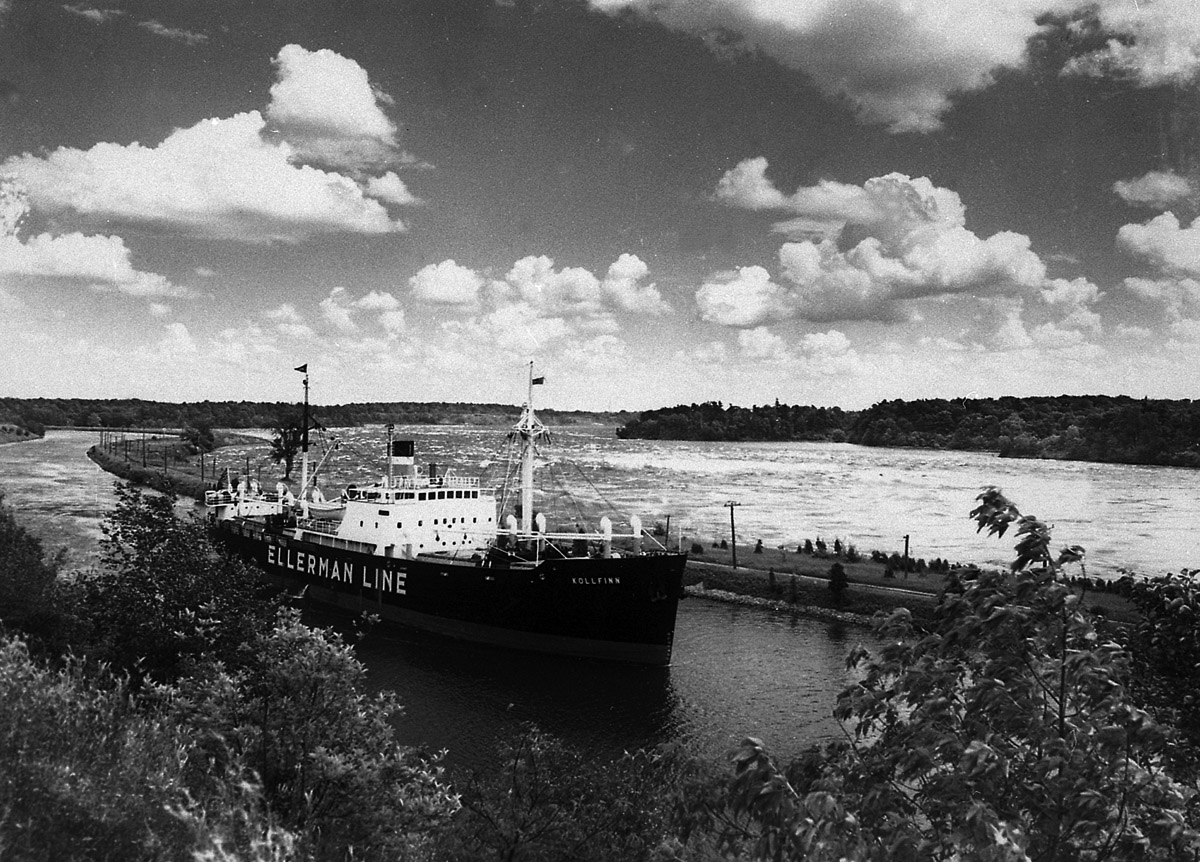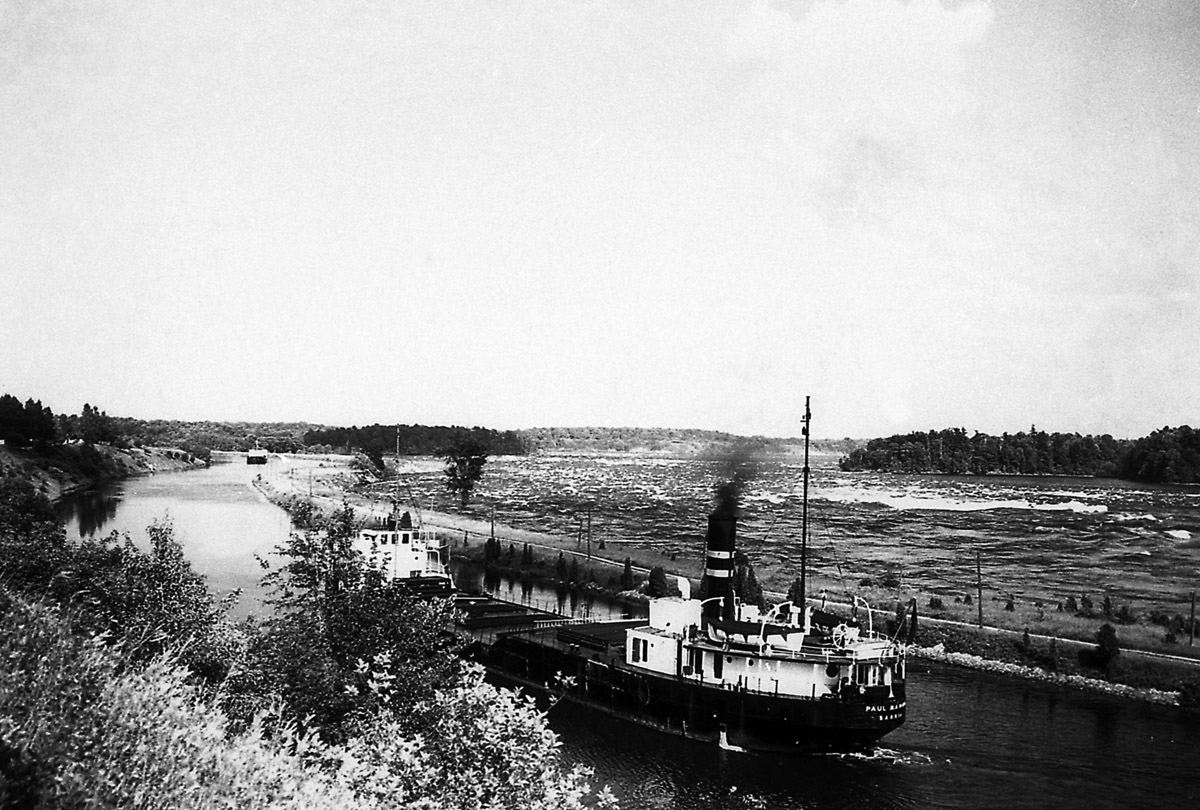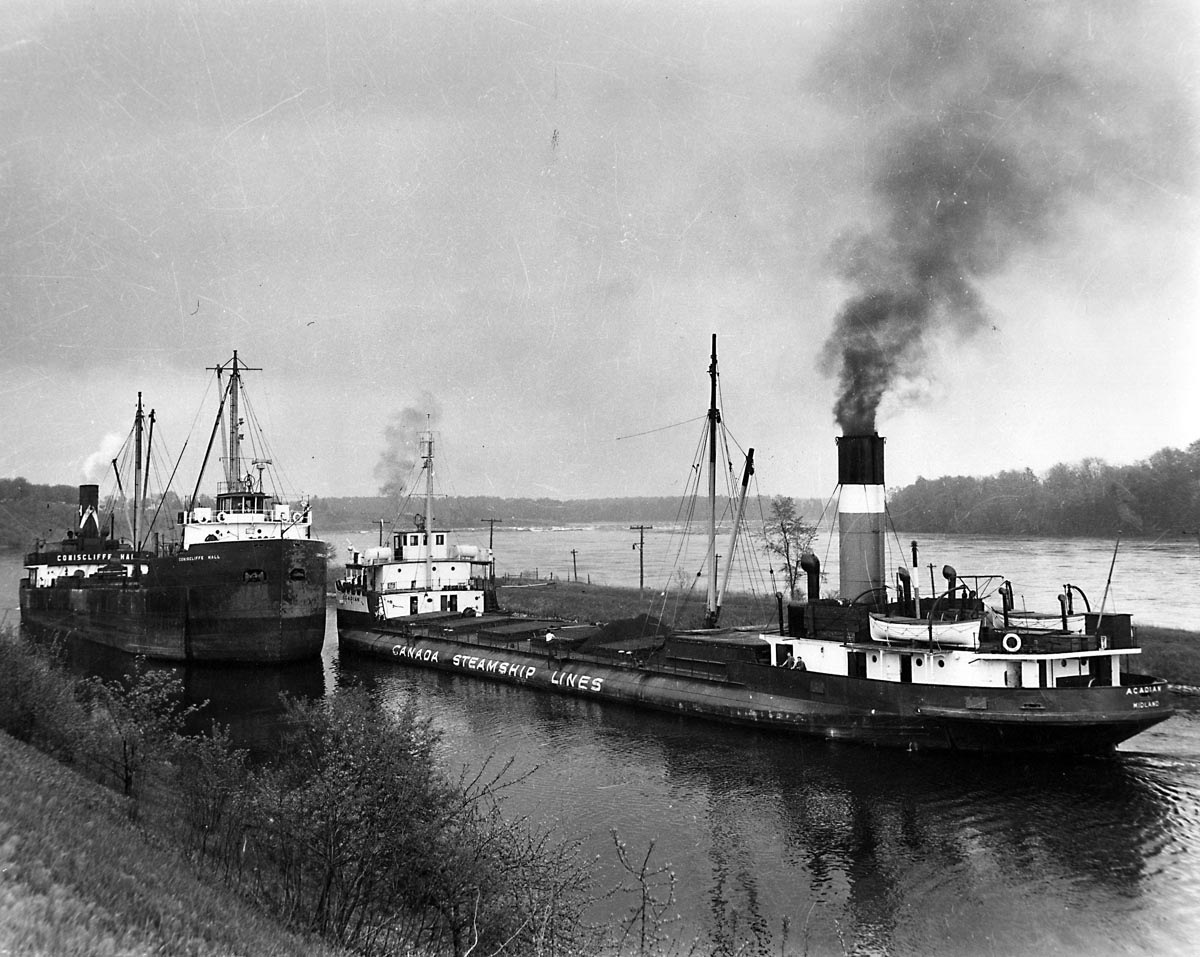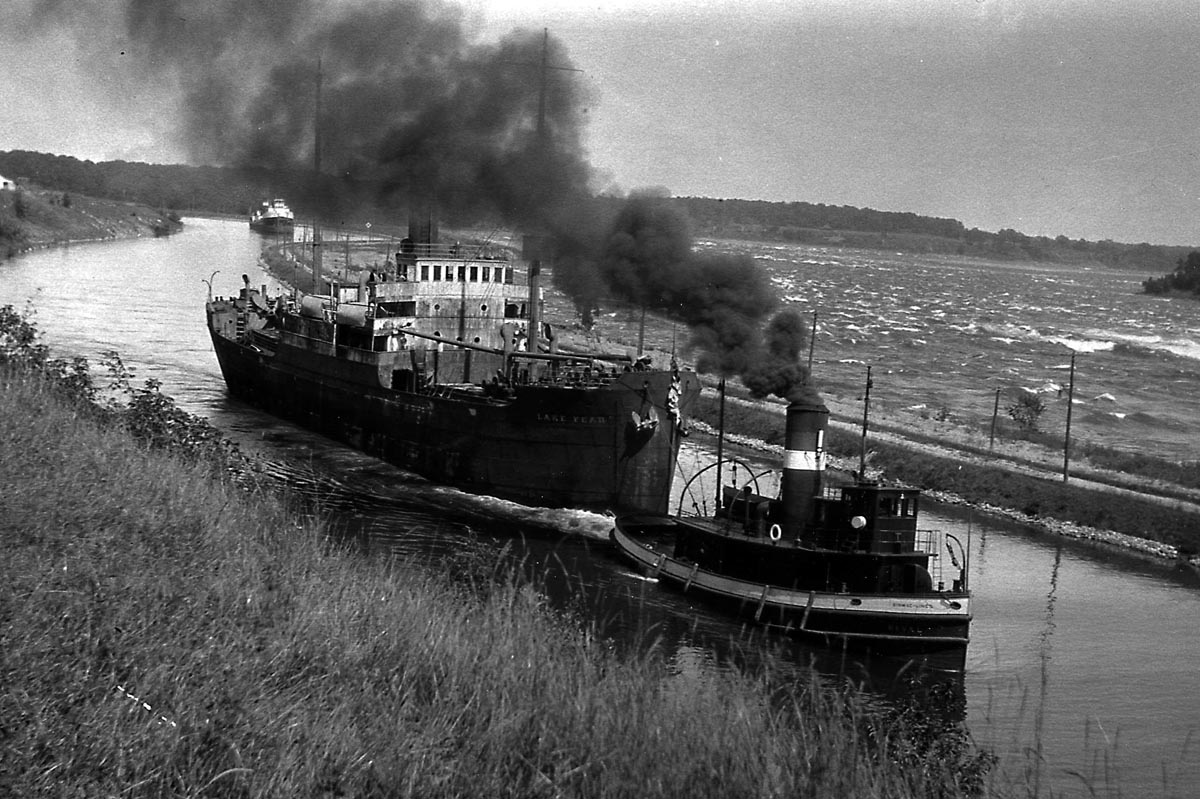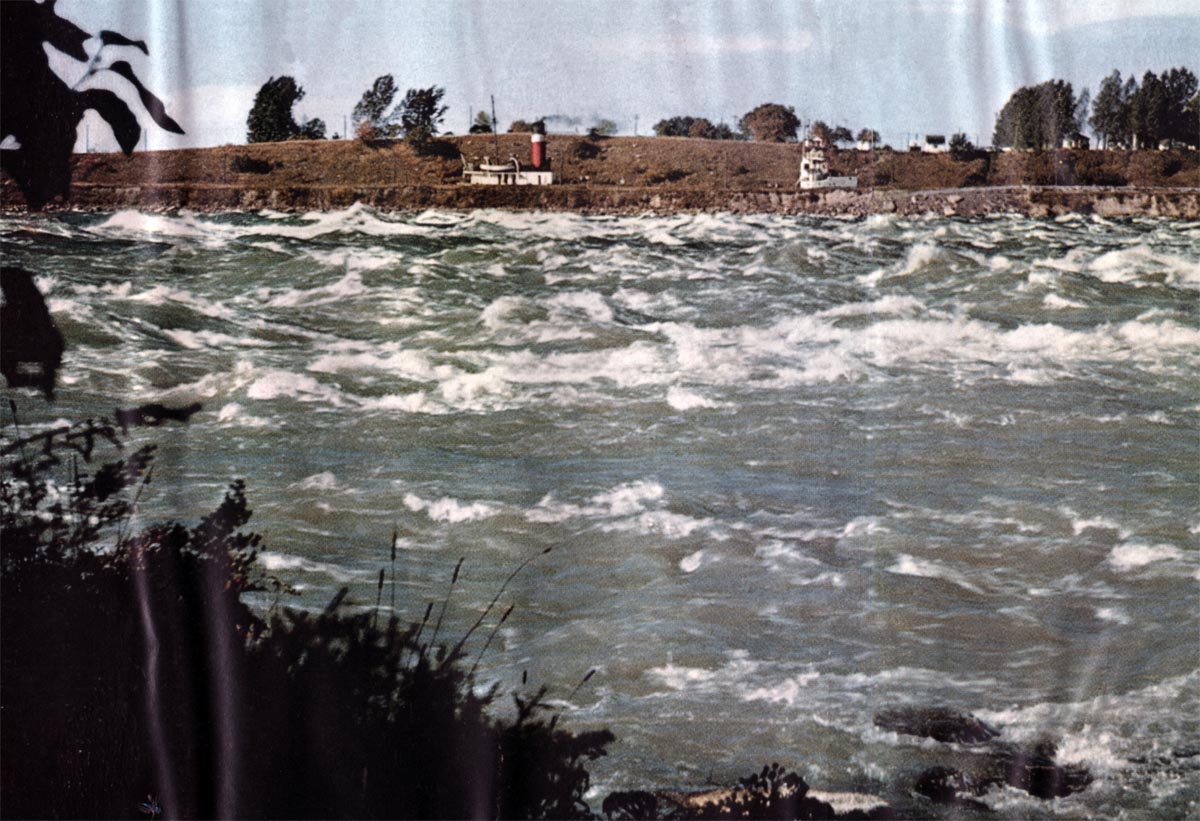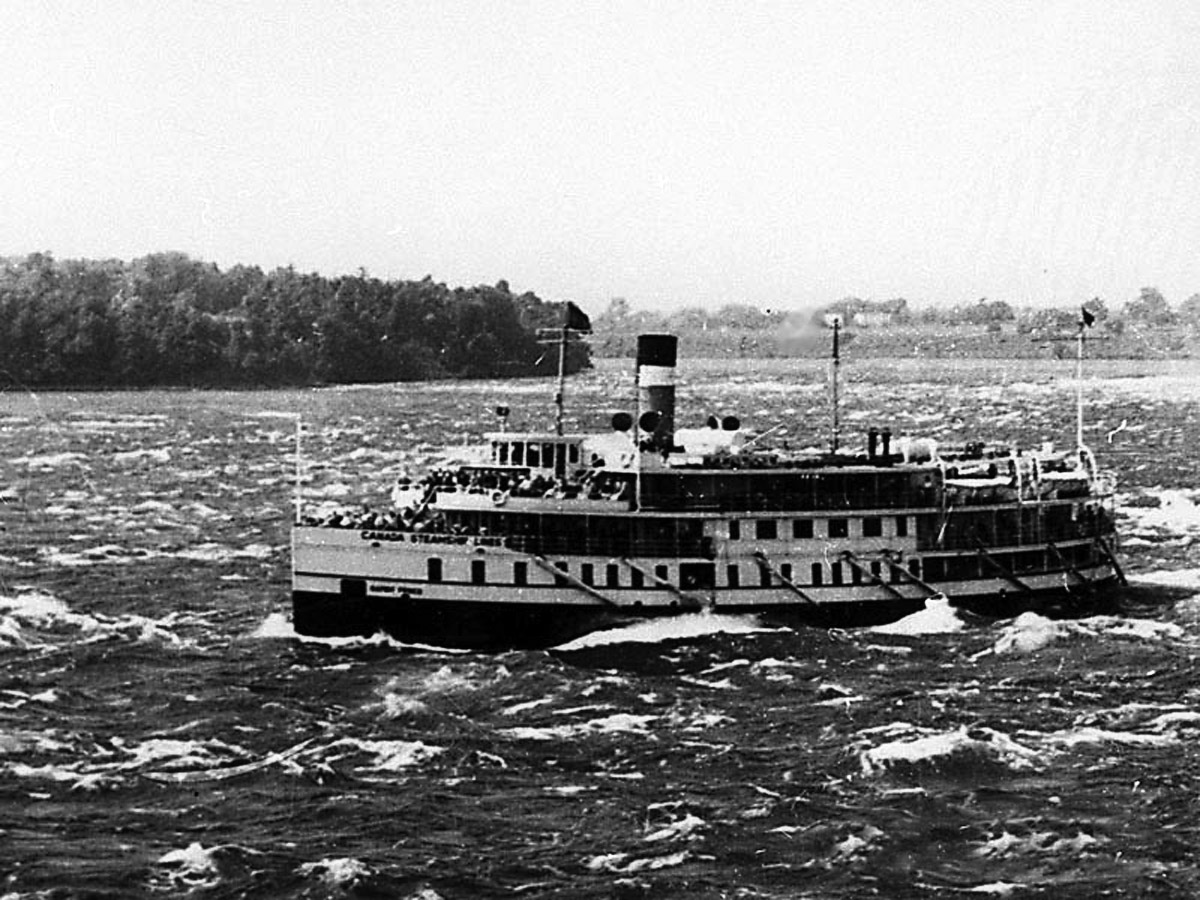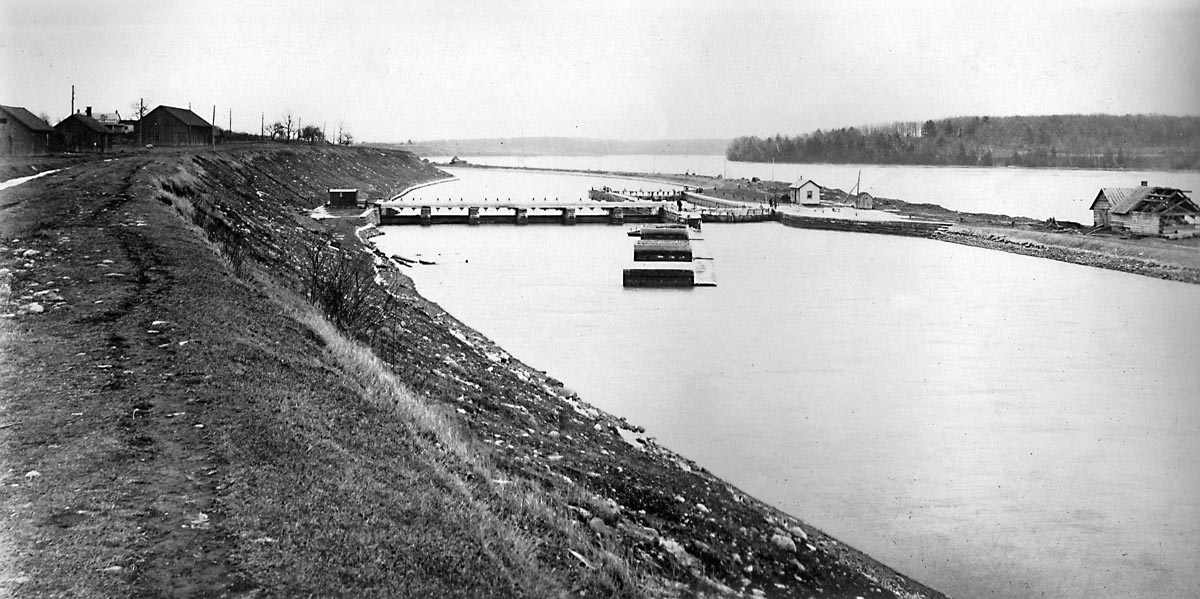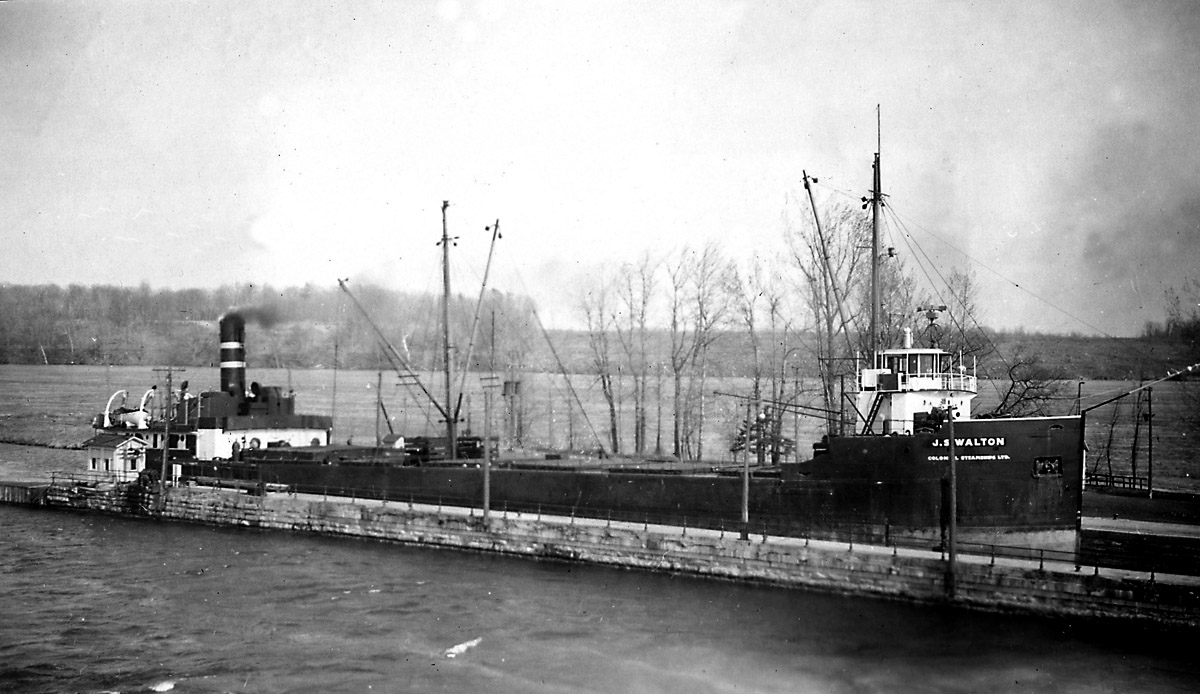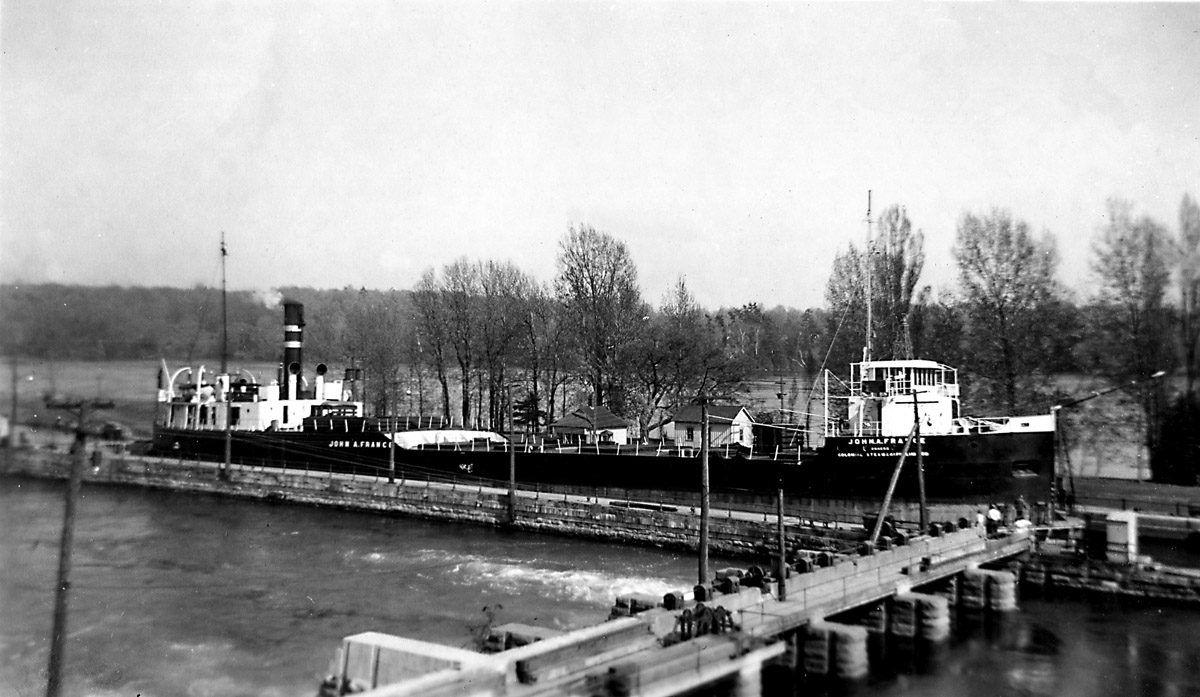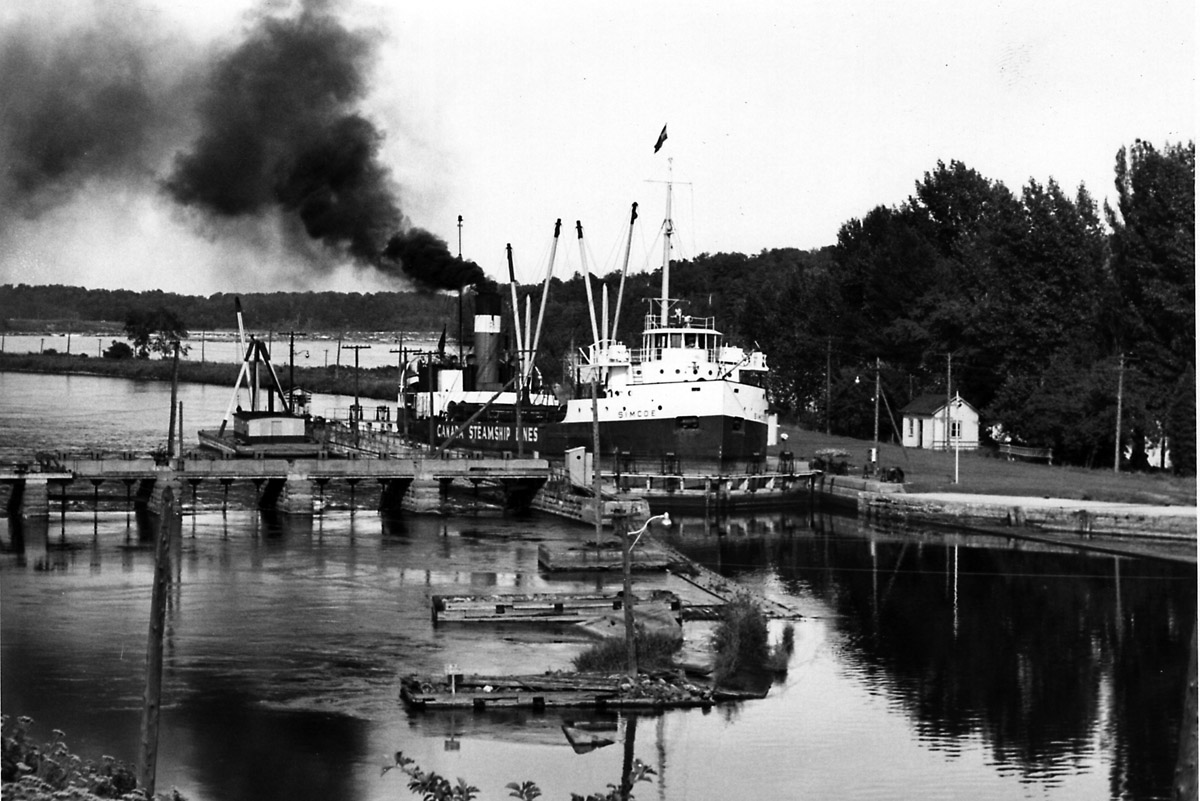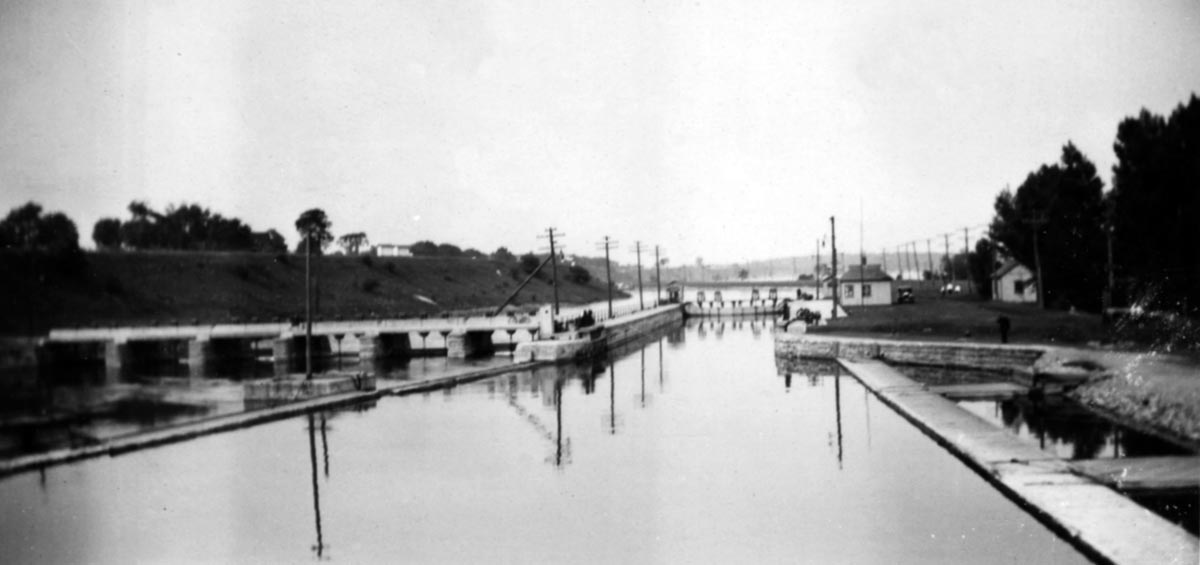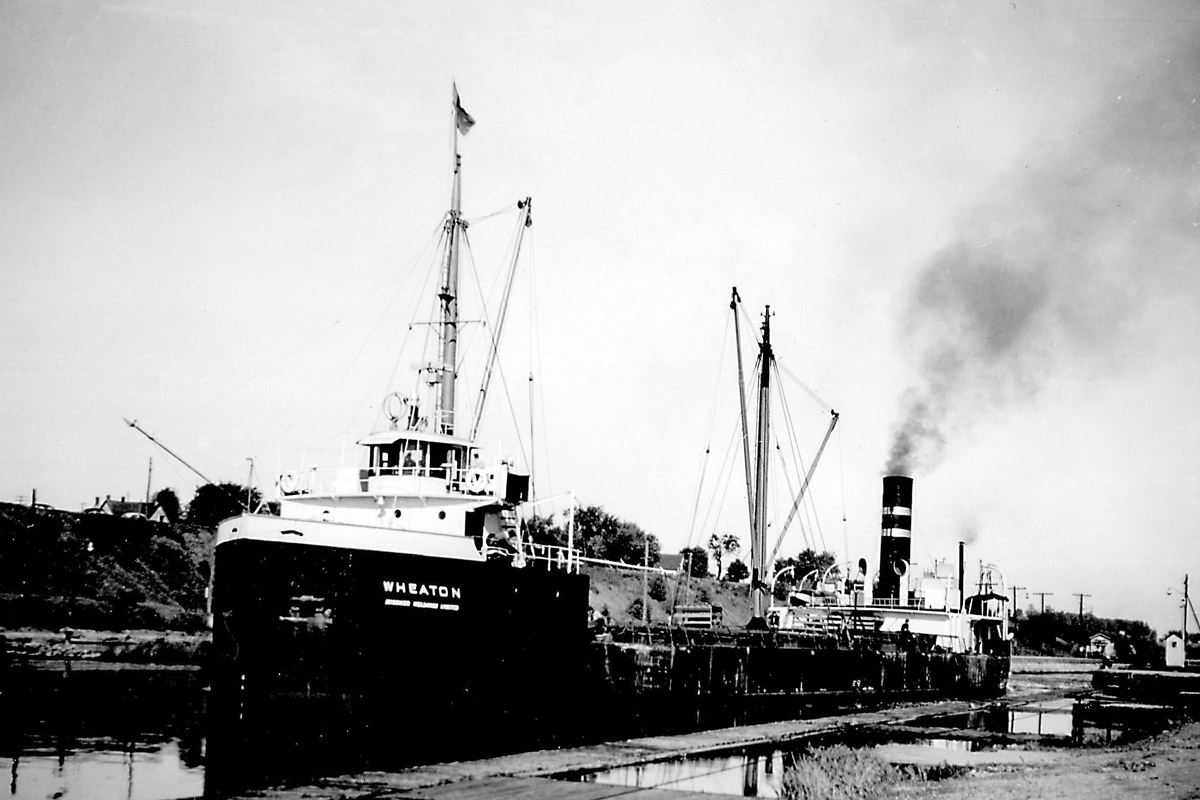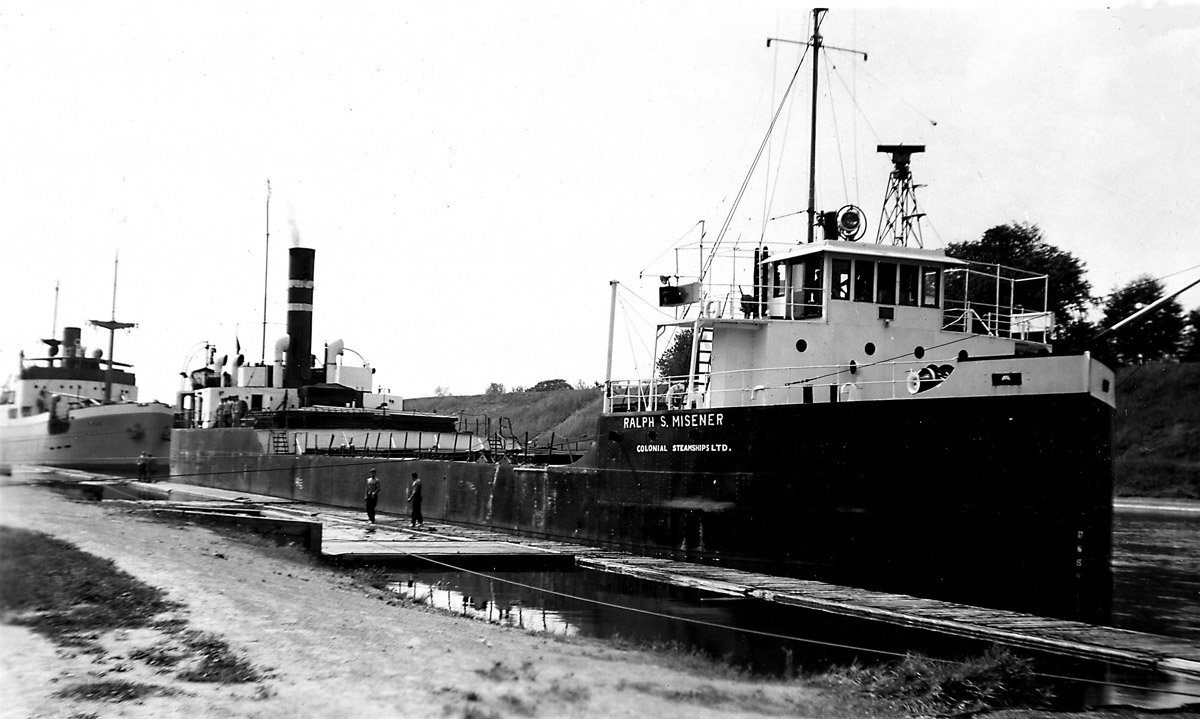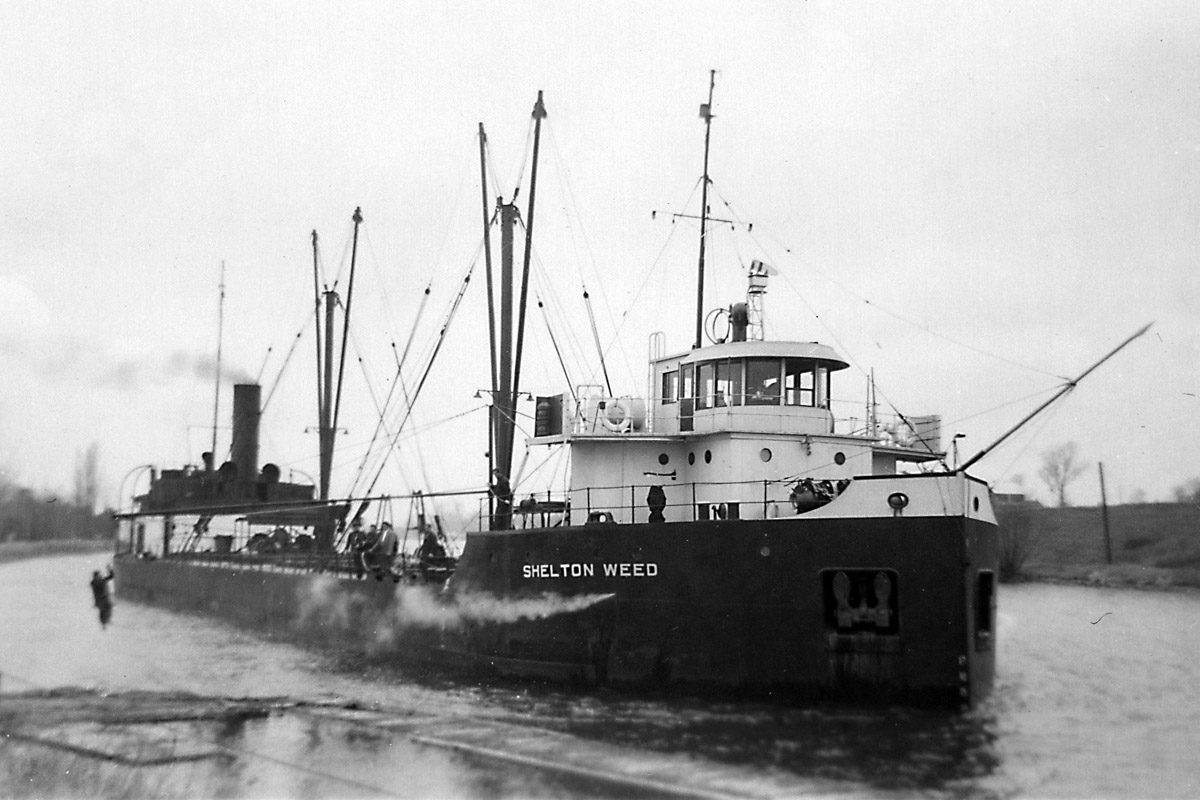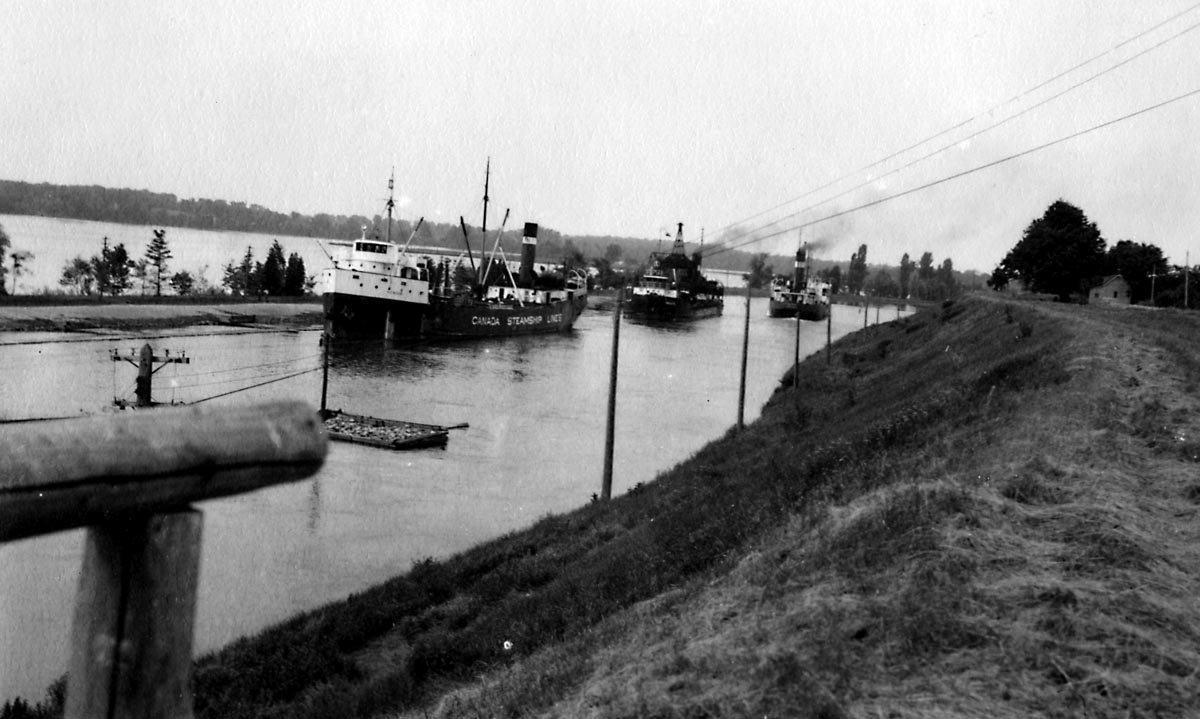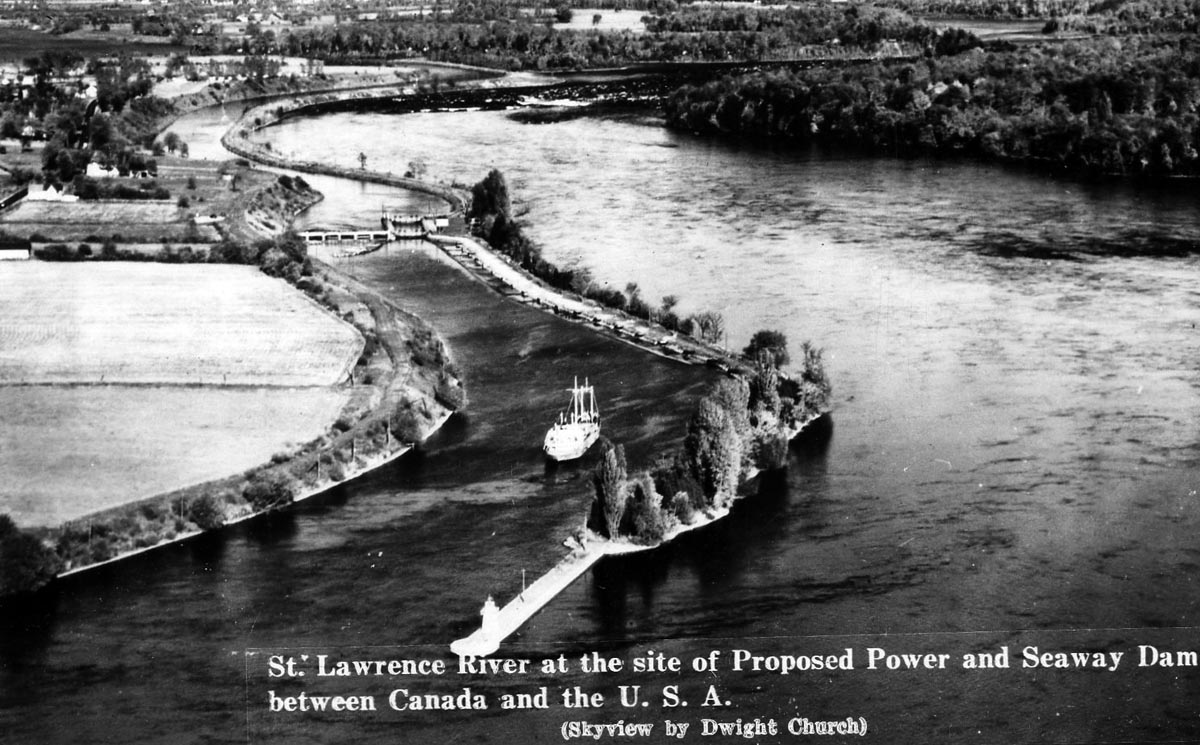Cornwall Canal
The entrance to the Cornwall Canal was 31 miles up the St. Lawrence River from Coteau Landing. This canal was built to bypass the Long Sault rapids. The first attempt at building this canal began in 1834 but financing difficulties and political unrest delayed the project until it finally opened in 1842. The first steamer, the HIGHLANDER, sailed from Montreal to Kingston that year.
|
But they were considered obsolete even then. The reconstruction to facilitate larger ships began in 1876 and continued until 1904. The work was slowed by having to ensure traffic through the 200 foot locks would not be interrupted. The new locks, built in parallel to the first set, would accommodate ships 245 feet long loaded to 14 foot draft with approximately 2500 tons of cargo.
|
ST. LAWRENCE WATERWAY
CORNWALL CANAL - Mileage - 11.00 - Total Lift - 48 ft.
Mile |
Description |
Dimensions |
Lift |
| 0.00 | Town of Cornwall | ||
| 0.01 | Lock 15 Cornwall | 270 x 45 x 14' | 12.7 ' |
| 0.25 | By-pass | ||
| 0.32 | Lock 17 Cornwall | 270 x 43' 8"x 14' | 13.3 ' |
| 0.82 | Highway Swing Br. | ||
| 1.65 | Lock 18 Cornwall | 270 x 45' x 14' | 8.0' |
| 1.84 | N.Y.C. Swing Br. | ||
| 3.16 | Lock 19 Cornwall | 270 x 45'x 14' | 6.0' |
| 4.76 | Lock 20 Cornwall | 270 x 45'x 14' | 8.0' |
| 5.04 | Guard Gate | ||
| 5.99 | Highway Swing Br. | ||
| 10.38 | Lock 21 Cornwall (Guard Lock) | 270 x 45'x 14' | 0.0' |
| 11.00 | Dickinson's Landing |
SHCC001: Map showing the route of the Cornwall Canal
SHCC001a: RAPIDS PRINCE docking below the canal in the harbour.
Steamer Rapids Prince berthing at the Government Dock at the foot of the canal. This steamer was the last passenger vessel on the river and did not operate after the 1949 season.
SHCC001b: The canaller TRENTON waits below Lock 15 of the Cornwall Canal for her turn to enter the lock
In the background can be seen the Canada Cotton Mill.
Photo dated 4 June 1955
SHCC002: Lock 15 of the Cornwall Canal.
This view of the entrance to the Cornwall Canal shows both the first and second versions of Lock 15. A down bound goelette is entering the “new” Lock 15 while a CSL package freight canaller waits for her turn below the lock. The 1842 version of Lock 15 is in the background. To the right is the buoy tender GRENVILLE.
SHCC003: Lock 15 of the Cornwall Canal
From left to right we the lock at was opened for service in 1842 and now lies abandoned except to store a gate lifter. To the right is the new Lock 15 which opened in the early 1900’s.
SHCC004 The Cornwall Dry Dock and entrance to the Cornwall Canal.
The dry dock was located between old Lock 16 and 17 with access through the latter. Draft into the dry dock was limited to 12 feet. An area of two acres was available for berthing ships. In the background are the old and new Locks 15 and eight canallers all waiting for a blockade of some sort to be cleared.
SHCC004a: Inside the Cornwall Dry Dock, March 28, 1956.
From left to right we have tug JENNIE M and the dredge DRAGUE NO. 1.
Photo by Dan McCormick.
SHCC004b: Canaller SANDLAND lies in the Cornwall Drydock.
This drydock was formerly the pool between Locks 16 and 17 of the first set of locks built at Cornwall. Entry to this drydock was through old Lock 17. The SANDLAND has a special trunk deck for the carriage of rolls of paper.
Photo dated 22 April, 1954.
SHCC005: Lock 15 of the Cornwall Canal
This photo shows the steamer CALGARIAN downbound in LocK 15, The funnel showing over the lock-house belongs to a British American tanker upbound in Lock 17. Lock 15, the lowest in the canal, opens into the river in the foreground.
Photo by Ivan Brookes, July 1939.
SHCC006: Basin between Lock 15 and Lock 17.
The basin between Locks 15 and 17, with the SS City of Montreal upbound. Note the absence of a Lock 16. This was due to the new locks requiring just two locks to lift the ships to the level above the first three locks of the old system.
Photo by Ivan Brookes Sept. 1, 1947.
SHCC006a: Canaller F W MOORE up bound in the pool below Lock 17.
The F W MOORE is up bound and manoeuvring carefully to enter Lock 17 of the Cornwall Canal. The Canal Office is seen to the right of the ship. The MOORE was another unit of the Colonial Steamship Company which was owned by Captain Scott Misener.
SHCC006b: Canaller SHIRLEY G TAYLOR in the pool between Locks 17 and 15.
The Upper Lakes Shipping canaller SHIRLEY G TAYLOR is passing the Canal Office located between Locks 17 and 15 of the Cornwall Canal.
Photo dated 7 July, 1954, by Dan McCormick
SHCC007: Looking up the canal at Lock 17.
CORNWALL CANAL Lock 17 - SS. SHELTON WEED downbound.
SHCC008: Lock 17 of the Cornwall Canal.
Lock 17 with the Keystone Transports steamer Keyvive downbound.
Photo by Ivan Brookes - Sept 1st 1947.
SHCC009: RAPIDS PRINCE upbound in Lock 17
Aptly named she was one of three CSL passenger ships that ran down the St. Lawrence River rapids from Prescott to Montreal. The other two were RAPIDS KING and RAPIDS QUEEN. At Prescott they connected with much larger ships that brought passengers down Lake Ontario from Toronto and other lake side communities.
SHCC010: The canal above Lock 17
Road swing bridge at mileage 0.82 between Locks 17 and 18. In the distance is the NY Central RR swing bridge.
SHCC011: The Stormont Mill.
Looking up the canal showing the swing bridge pier on the left. Steamer KENORA passing the Stormont Mill.
SHCC012: The canal viewed from the Stormont Mill.
The canal from Lock 17 (extreme right) to the Cornwall Road Swing Bridge. The C.S.L. shed is seen beyond the bridge.
SHCC013: Howard Smith Paper dock
Howard Smith Paper Mills on the canal below Lock 18. Motor Vessel St. Simeon C. unloading pulp logs - July 11th, 1950. Pulpwood piled high in the background.
Photo by Ivan Brookes.
SHCC014: Lock 18 – Cornwall Canal
Svanefjell (Norway) downbound in Lock 18 - Sept. 1st 1947.
Photo by Ivan Brookes
SHCC015: Lock 18 – Cornwall Canal.
Lock 18 looking east. Cornwall's old waterworks and pumphouse are on the right. Dating from the mid 1880s, the building was demolished in 1962. Today only some riverside foundations are left. The old hydro-electric plant can be seen in the distance right of centre - about 1935. The Howard Smith Paper dock is to the left.
SHCC016: Lock 18 – Cornwall Canal.
Lock 18 - this view was taken from the New York Central Swing Bridge. Lock dimensions are 270x45x14' - lift is only 8'. The canaller SIOUX, in St. Lawrence Steamship Co. colours, waits her turn above the lock.
SHCC016a: Aerial View of Lock 18 area in 1920.
The Howard Smith Paper Co. and Lock 18 are centered in this 1920 aerial view. The NY Central Bridge over the canal and St. Lawrence River is to the right.
SHCC017: New York Central Swing Bridge.
New York Central Swing Bridge at Mile 1.84. The steamer passing through is either the THOROLD or the SHELTER BAY of the Quebec & Ontario Transportation Co. fleet. Photo from before 1940.
SHCC018: Lock 19 – Cornwall Canal.
The lower entrance to Lock 19.
Photo by Ivan Brookes - July 11, 1950.
SHCC019: Lock 19 upper level.
The Halco steamer SHIERCLIFFE HALL, loaded with pulpwood, is raised in Lock 19.
Jim Kidd photo, Oct. 31, 1957.
SHCC024: Looking up the canal at Lock 20.
At mile 4.76 is Lock 20 of the Cornwall Canal.
Ivan Brookes photo, July 11, 1950.
SHCC025: An aerial view of Lock 20.
From left to right are the new 270’ lock, then the old 200’ lock, and the weir for water flow and level control. The guard gate is seen at the top of this image. The village nearby is Maple Grove.
SHCC026: The basin above Lock 20.
The Halco canaller CONISCLIFFE HALL, her decks piled high with coal, waits in the basin above Lock 20 while the Keystone Transports canaller KEYSHEY is lowered in the lock. Two more ships can be seen waiting below the lock.
SHCC027: CASABLANCA between Lock 20 and the Guard Gate.
CASABLANCA flies the flag of Holland, where she was built in 1951. Behind her is Misener’s canaller CLAYTON down bound into Lock 20. In the background behind CASABLANCA’s bow the rapids are dry and the power dam is being built.
SHCC028: Passing through the Guard Gate.
Three lakers waiting above the Guard Gate while a foreign vessel passes through upbound.
SHCC029: The Guard Gate
Guard Gate - This structure is situated at mileage 5.04. In this view, looking down the canal, the French vessel "Marquette" is seen upbound in Lock 20. Photo was taken on August 4th, 1954.
Photo by Ivan Brookes.
SHCC030: Mille Roches area.
This aerial view, taken over Sheek Island, which appears at the bottom, looks down the St.Lawrence River. The canal appears at the upper left. Mille Roches swing bridge is visible, but the guard gate is out of sight around the lower bend. The small power plant in the foreground belongs to the St.Lawrence Power Co.
SHCC031: Canaller passing through the Mille Roche swing bridge.
A Quebec & Ontario canaller sails through the draw of the Mille Roche swing bridge. This bridge connected the mainland to Sheek Island. From here a road ran up the canal bank to the lock at Dickinson’s Landing.
Photo by Ivan Brookes, July 11, 1950.
SHCC033a: NORMAN B MACPHERSON up bound Cornwall Canal.
The Upper Lakes & St. Lawrence Transportation Co. canaller NORMAN B MACPHERSON sailing up the Cornwall Canal in ballast. She is passing the Long Sault Rapids just below Dickinson’s Landing.
SHCC033b: KEYPORT loaded with pulpwood.
Steamer KEYPORT - this section of the canal between Lock 20 & 21 is sometimes referred to as the Long Sault Canal.
SHCC033c: The salt water ship Kollfinn rounding the bend in the Corwall Canal.
The salt water ship Kollfinn rounding the bend in the Corwall Canal below Dikinson's Landing. The Long Sault Rapids are to the right.
SHCC033d: Kollfinn slowly approaching Lock 21.
Kollfinn is a Norwegian flag ship built at Langesund, Norway, in 1952. She is slowly approaching Lock 21.
SHCC033e: Misener canaller PAUL MANION.
The Misener canaller PAUL MANION heading down the Corwall Canal after departing Lock 21.
SHCC034: Two Canallers Passing.
CONISCLIFFE HALL meeting ACADIAN a short distance below the lock at Dickinson’s Landing.
The man in the white shirt hanging over the side of ACADIAN will call out “Not Clear” until he sees daylight between the two ships. The loaded ship has the right to “take his half out of the middle.”
SHCC035: Scrap tow.
Tug RIVAL brings the former war built steamer LAKE FEAR up the Cornwall Canal. This old ship was built on the Great Lakes during WWI. She is bound for the Ford plant in Detroit where she will join hundreds of similar ships bound for the steel furnaces. The propeller stored aft was removed from the tail shaft to reduce drag. Everything from these old ships was recycled.
SHCC036: The Long Sault Rapids.
LONG SAULT RAPIDS below Dickinson's Landing, with a CSL Canaller downbound.
SHCC036a: RAPIDS PRINCE in Long Sault Rapids.
RAPIDS PRINCE shooting down the Long Sault Rapids. She was the last passenger ship to do so in 1949. The run was from Prescott to Montreal down all the rapids and return via the canals back up the river.
SHCC039: Lock 21 at Dickinson’s Landing.
A view of Lock 21 shortly after completion. Circa 1904.
SHCC039A: Canaller J S WALTON entering Lock 21.
The J S WALTON is another unit of the Colonial Steamships Ltd., which was owned by Captain R. Scott Misener. She is entering Lock 21 at Dikinson's Landing, the upper entrance to the Cornwall Canal.
Date: 24 April, 1955. Dan McCormick photo
SHCC039B: JOHN A FRANCE in Lock 21 at Dikinson's Landing
Look closely at the bow of the ship in the lock. It is almost touching the closed upper gates. The position of the ship as it slowly approached these wooden gates was controlled by a special snubbing winch and cable leading aft to a bollard on the canal lock wall. In the foreground is the weir that controlled flow into the Cornwall Canal and therefore the overall level of water in the canal.
Date: 8 May, 1953. Dan McCormick photo
SHCC039C: SIMCOE in Lock 21 at Dikinson's Landing.
The CSL canaller SIMCOE is being raised in Lock 21 at Dikinson's Landing. The fireman is shovelling coal into the boiler to raise steam pressure for the run up the river.
Jim Kidd photo.
SHCC040: Lock 21 at Dickinson’s Landing
Looking down into the chamber of Lock 21.
SHCC040A: WHEATON departing Lock 21 up bound.
The Colonial Steamships Ltd. canaller WHEATON is up bound with cargo. She has just cleared Lock 21 at Dikinson's Landing. Date: 7 Oct. 1955.
Dan McCormick photo.
SHCC040B: RALPH S MISENER secured above Lock 21 at Dikinson's Landing.
The RALPH S MISENER is secured to the floating docks located on the south side of the upper approaches to Lock 21 at Dikinson's Landing. A salt water ship waits behind her.
Date 3 Sept. 1953 Photo by Dan McCormick
SHCC040C: SHELTON WEED landing a man ashore.
The SHELTON WEED places a man on the dock above Lock 21 at Dikinson's Landing as she makes the dock. The landing boom will be swung back to send another crewman ashore to help with the lines. A heaving line is attached to a mooring line and the men ashore will pull the mooring line ashore until it can be placed over a bollard
SHCC041: Ships wait above Lock 21.
KENORA and the self-unloader COLLIER wait their turn above Lock 21 at Dickinson’s Landing.
SHCC042: A salty arrives at Dickinson’s Landing.
An aerial view of the upper entrance to the Cornwall Canal and Lock 21 at Dickinson’s Landing. On the end of the pier can be seen Dickinson’s Landing Light. A square wooden tower 22 feet high established in 1891, replacing the original built in 1865. The light, 21 feet above low water is visible for 3 miles.
Please see the Seaway Construction Gallery for photographs from the Cornwall Canal during the construction of the current St. Lawrence Seaway from 1952 to 1958.


